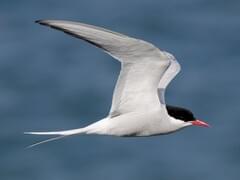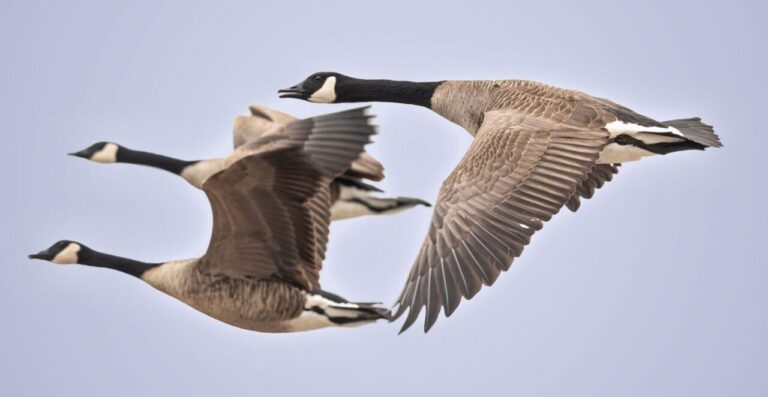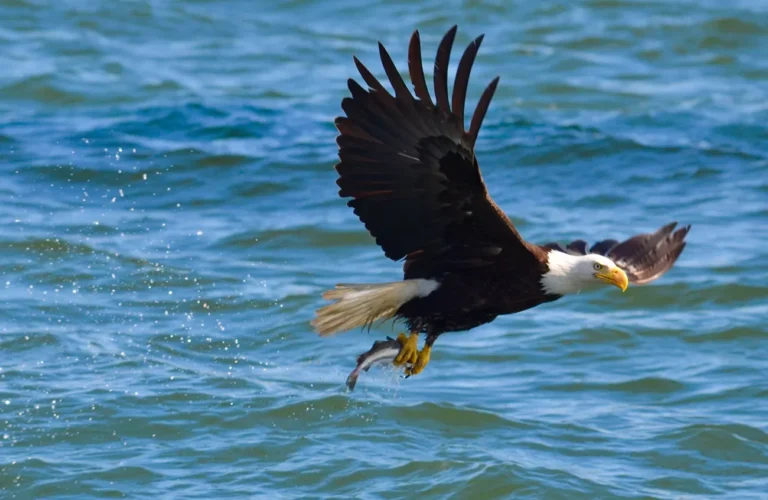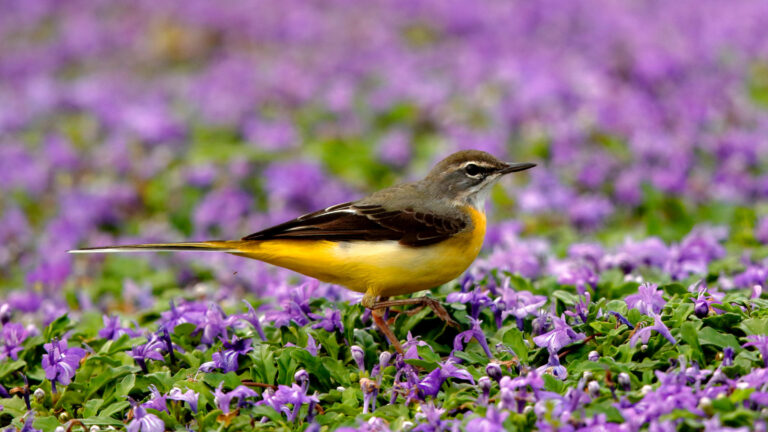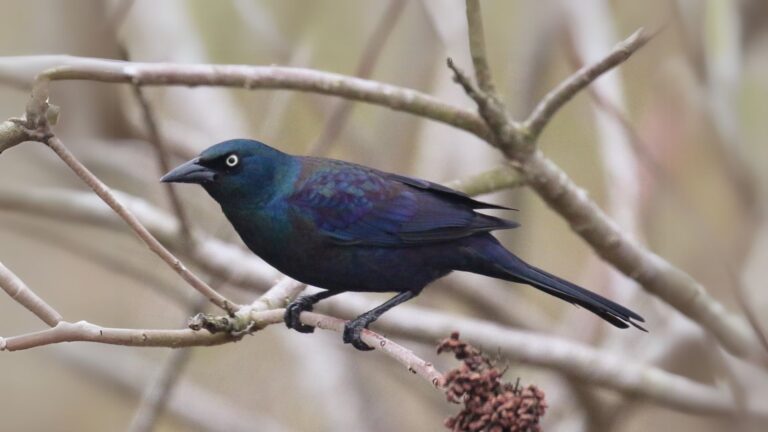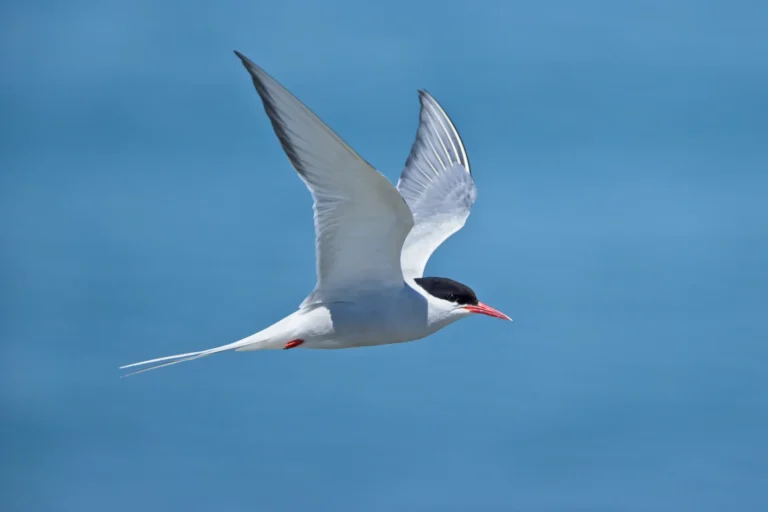Orders of Birds: Exploring the Wonderful World of Wings
How Scientists Group Living Things: A Peek into Taxonomy
What is Classification?
Have you ever sorted your toys, video games, or books? Humans naturally group things together to make sense of the world around them.1 Scientists do the same thing, especially when studying the millions of different living things on Earth.2
Biological classification, also called taxonomy, is the scientific way scientists organize and categorize all life.3 They group living things based on features they share, looking at similarities and differences.4 Think of it like a library: books are sorted into sections like kids’ books or adult books, then into fiction or non-fiction, and finally down to a single book.4
This system helps scientists study life more easily and understand how different creatures are related to each other.4 It also gives every living thing a unique scientific name, which avoids confusion. For example, the animal called a puma in one place might be called a cougar or mountain lion elsewhere, but its scientific name is always the same.7 Using classification helps everyone communicate clearly about nature.5
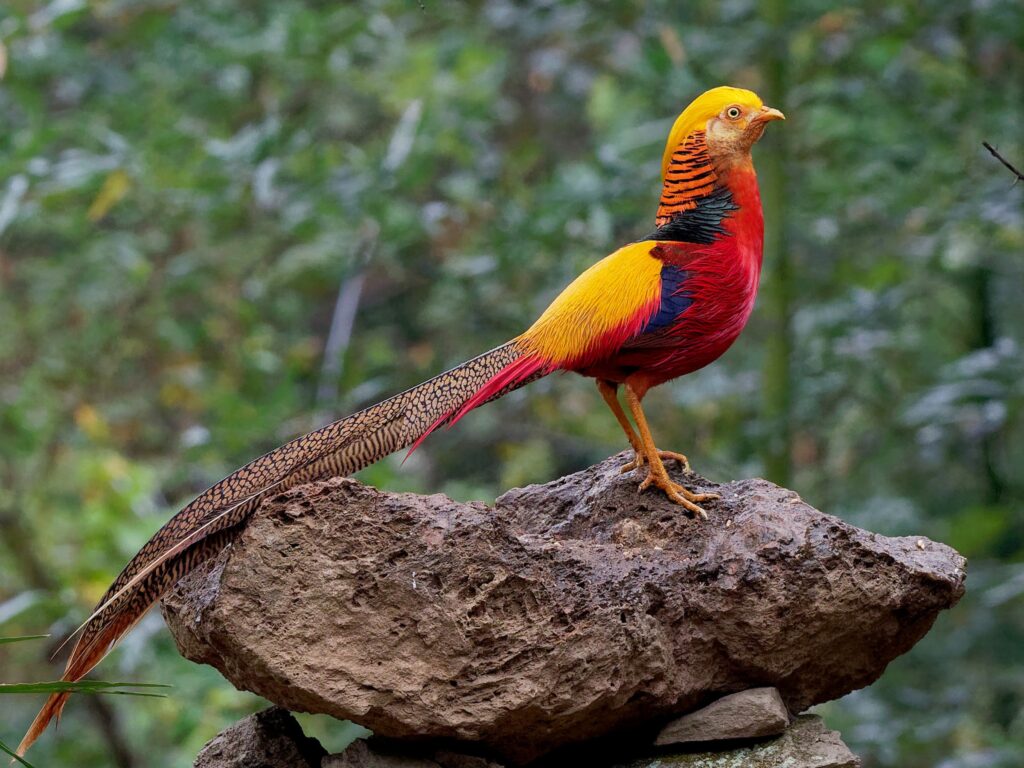
Levels of Life: Like Nesting Dolls
Scientific classification uses different levels, like Russian nesting dolls or boxes fitting inside bigger boxes.3 Each level is a group, called a taxon (plural: taxa), that fits inside the level above it.5 The groups start very broad and get more specific as you go down the levels.3
There are eight main levels, or ranks, used today. From the biggest, most general group to the smallest, most specific group, they are: Domain, Kingdom, Phylum, Class, Order, Family, Genus, and Species.4 A fun way to remember this order is the sentence: “King Phillip Came Over For Good Spaghetti”.4
The top levels group life in very broad ways. Domain is the highest level, splitting life into three main types based on their cells: Bacteria, Archaea (both tiny single-celled life without a nucleus), and Eukarya (life forms with a nucleus in their cells, including plants and animals).1
Within Eukarya are Kingdoms, like Animalia (animals) and Plantae (plants).3 Animals are then grouped into Phyla (singular: Phylum); for example, animals with backbones belong to Phylum Chordata.4 Within a phylum are Classes, like Mammalia (mammals) or Aves (birds).1
Table 1: Levels of Classification (Example: Mallard Duck)
| Level | Description | Example: Mallard Duck (Anas platyrhynchos) |
| Domain | Very Broad Group | Eukarya (Cells have a nucleus) |
| Kingdom | Broad Group | Animalia (Animal) |
| Phylum | Group within Kingdom | Chordata (Has a backbone) |
| Class | Group within Phylum | Aves (Bird) |
| Order | Group within Class | Anseriformes (Waterfowl) |
| Family | Group within Order | Anatidae (Ducks, Geese, Swans) |
| Genus | Group within Family | Anas (Dabbling Ducks) |
| Species | Very Specific Group | platyrhynchos (Mallard) |
This table shows how scientists classify the common Mallard duck. Notice how each level gets more specific, narrowing down the group until we reach the unique species. This hierarchical system helps organize the vast diversity of life.10
Focusing on Birds: Order, Family, Genus Explained
Have you ever wondered how many orders of birds there are? There are 40 – 44 depending who you ask! All birds belong to the Class Aves.1 Within this class, scientists use the levels of Order, Family, Genus, and Species to group birds more specifically based on shared traits. These groupings often reflect how closely related birds are, like branches on a giant family tree.1
An Order is a large group within a Class.12 Birds in the same order share major characteristics, like body shape, beak type, or lifestyle. Think of “vehicles” as a Class; Orders might be like “Cars,” “Trucks,” or “Motorcycles”—different main types.5 Bird Orders group together major kinds of birds, like waterfowl (ducks and geese), owls, or parrots.
A Family is a more specific group within an Order, containing one or more related Genera.12 Birds in the same family are more similar to each other than birds that are only in the same Order.10 Using the vehicle analogy, if “Cars” is the Order, Families might be like “Ford,” “Toyota,” or “Honda.” Many animal family names end in “-idae,” like Anatidae, the family containing ducks, geese, and swans.1
A Genus (plural: Genera) is a group of very closely related species.3 These species usually share a recent common ancestor and look quite similar.1 Think of the Genus like a specific model line within a car brand, such as “Toyota Camry” or “Toyota Corolla”.11 The Genus is the first part of an animal’s two-part scientific name and is always capitalized and italicized, like Anas for many ducks or Homo for humans.2
A Species is the most specific main level.3 It usually refers to a group of animals that can breed together and have babies that can also have babies.2 In our car analogy, the Species is like the specific trim level, such as “Camry LE” or “Camry XSE”. The species name (or specific epithet) is the second part of the scientific name, written in lowercase and italics, like platyrhynchos for the Mallard.7 The unique two-part scientific name (Genus species) is called binomial nomenclature.11
The Amazing Orders of Birds (Class Aves)
The world of birds (Class Aves) is incredibly diverse, with tiny hummingbirds, giant ostriches, and everything in between. To make sense of this variety, scientists group birds into roughly 40 to 44 Orders based on shared features and evolutionary history.16
Different scientific groups sometimes disagree slightly on the exact number of orders as new information, especially from DNA studies, helps refine our understanding.1
We will explore these major groups one by one, following a widely used list. Each Order represents a unique branch on the bird family tree.
17
1. Order Struthioniformes – Ostriches
General Characteristics: This order includes the world’s largest living birds, the ostriches. They are flightless birds built for running, with powerful legs and only two toes on each foot.16 They live in open country in Africa.
Example: Common Ostrich
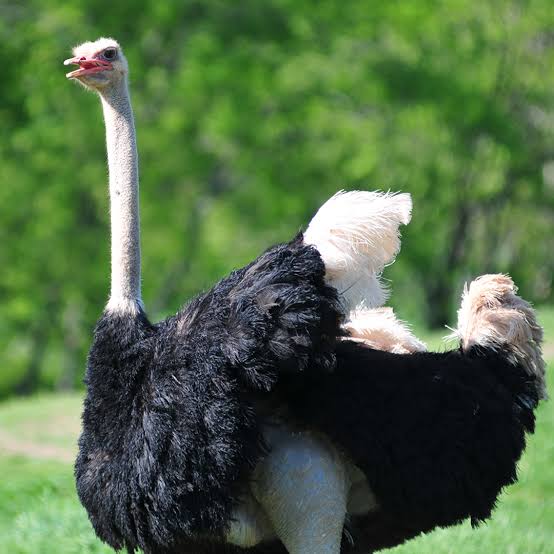
Description: The Common Ostrich (Struthio camelus) is found across African savannas and deserts.17 Male ostriches have bold black and white feathers, while females are mostly brownish-gray. They can run at high speeds to escape predators.
2. Order Rheiformes – Rheas
General Characteristics: Rheas are large, flightless birds from South America, similar to ostriches but smaller. They have three toes on each foot and prefer open grasslands or scrublands.16
Example: Greater Rhea
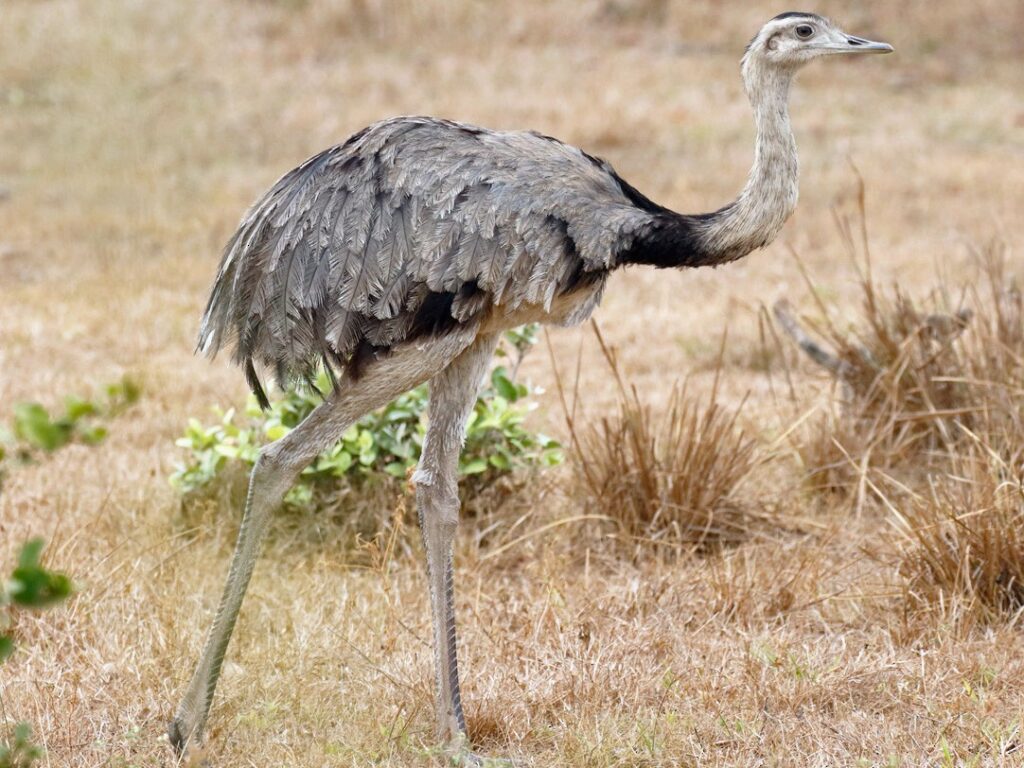
Description: The Greater Rhea (Rhea americana) lives in the grasslands and open woodlands of South America. It has grayish-brown plumage and long legs for running. Males incubate the eggs and care for the young.
3. Order Tinamiformes – Tinamous
General Characteristics: Tinamous are ground-dwelling birds found in Central and South America. They look somewhat like partridges or quail and are secretive birds that can fly, but usually prefer to run or hide.16 They are considered part of the ancient Palaeognathae group along with ostriches and rheas.
Example: Elegant Crested Tinamou
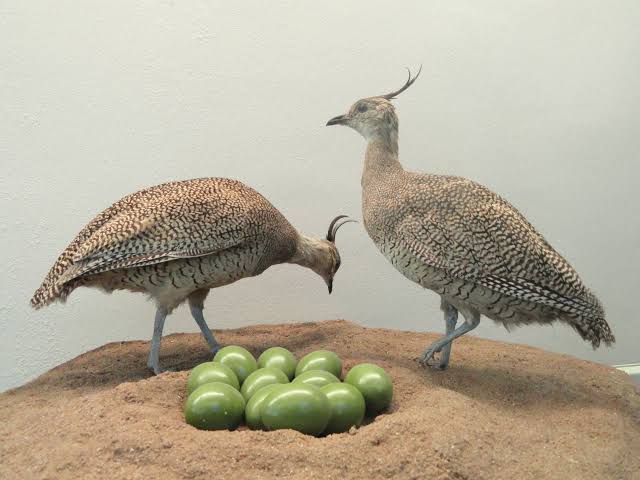
Description: The Elegant Crested Tinamou (Eudromia elegans) inhabits grasslands and scrub in southern South America.17 It has intricately patterned feathers for camouflage and a distinctive forward-curling crest. They make high-pitched whistling calls.
4. Order Casuariiformes – Cassowaries and Emu
General Characteristics: This order contains the Emu from Australia and the Cassowaries from New Guinea and northeastern Australia. They are large, flightless birds with powerful legs and three toes.16 Cassowaries are known for the bony casque on their heads.
Example: Southern Cassowary
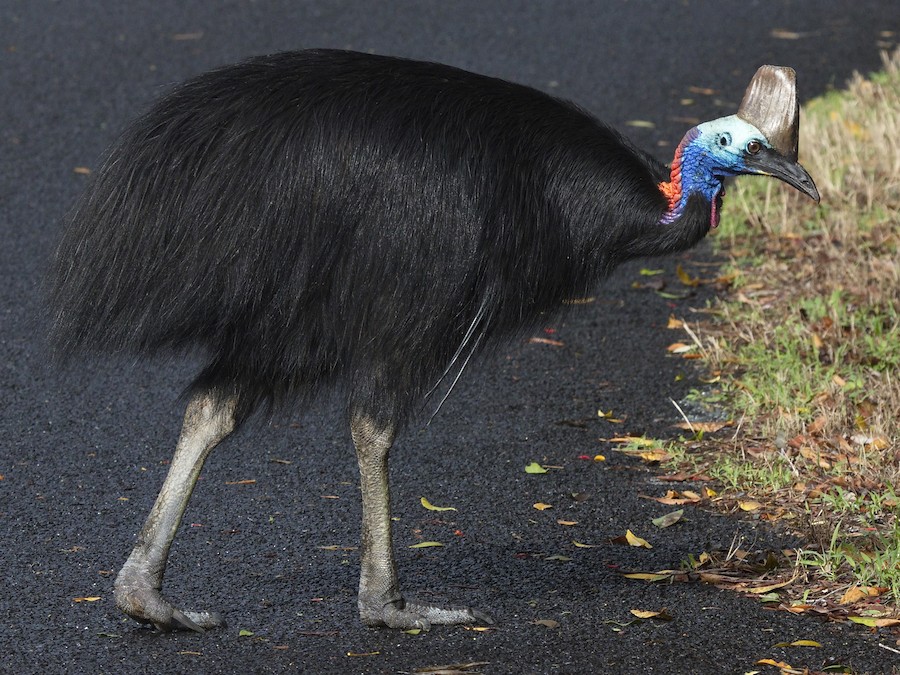
Description: The Southern Cassowary (Casuarius casuarius) lives in the tropical rainforests of New Guinea and northeastern Australia.17 It has glossy black plumage, a brightly colored blue and red neck, and a tall casque. They possess a dangerous dagger-like claw on their inner toe.
5. Order Apterygiformes – Kiwis
General Characteristics: Kiwis are small, flightless birds endemic to New Zealand. They have hair-like feathers, tiny wings, and a long beak with nostrils at the tip, which they use to sniff out insects and worms in the soil.16 They are mostly nocturnal.
Example: Brown Kiwi
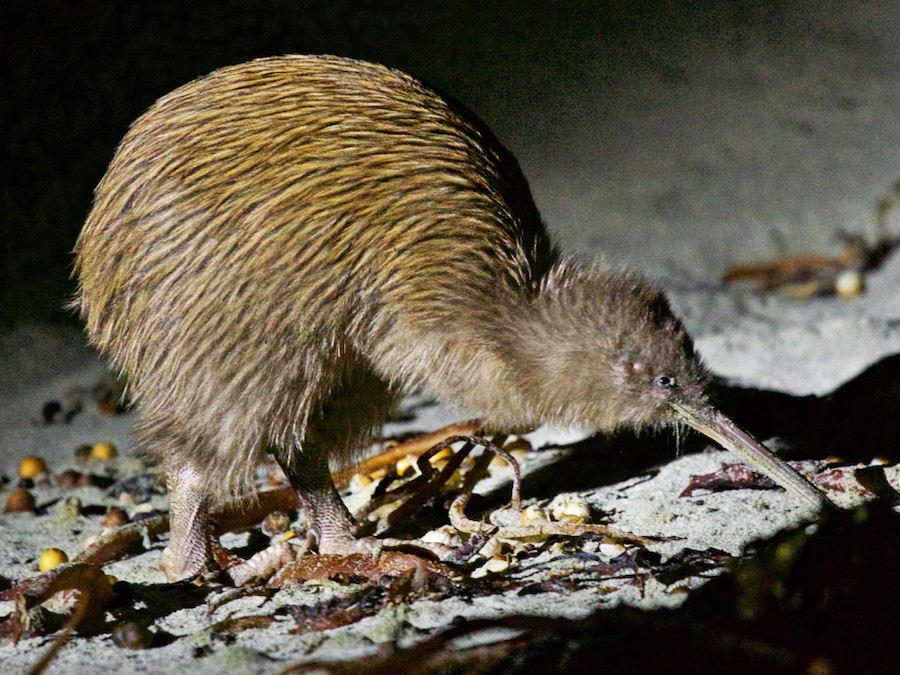
Description: The Brown Kiwi (Apteryx mantelli) is found in forests and scrublands of New Zealand’s North Island.17 It has shaggy brown feathers and is about the size of a domestic chicken. Kiwis lay enormous eggs relative to their body size.
6. Order Anseriformes – Waterfowl
General Characteristics: This large order includes ducks, geese, and swans, birds highly adapted for life on water. They typically have webbed feet for swimming and broad, flattened bills for feeding on plants or small aquatic animals.1 This group and the next (Galliformes) form a major branch called Galloanseres near the base of the modern bird family tree.16
Example: Mallard
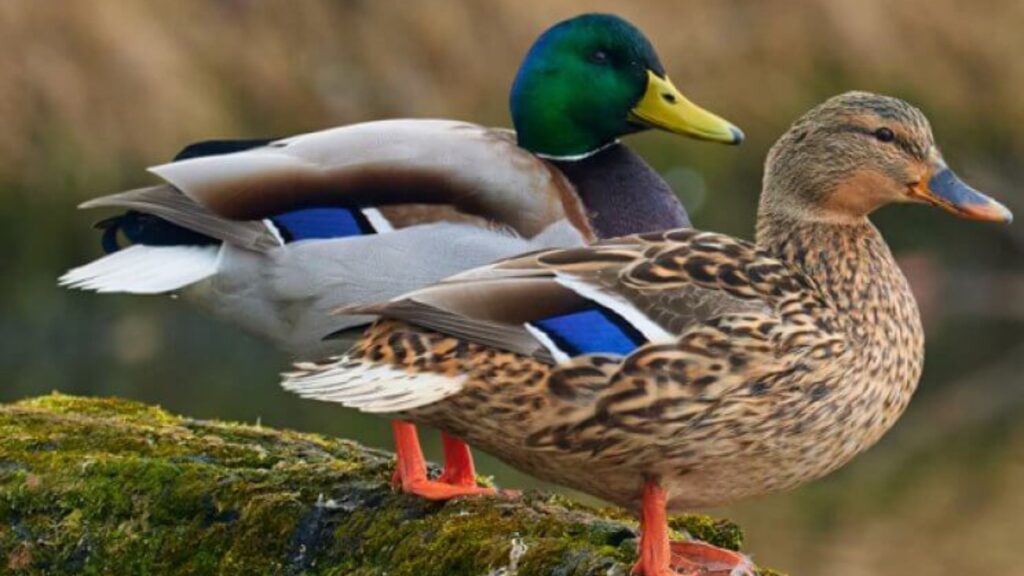
Description: The Mallard (Anas platyrhynchos) is one of the most recognizable ducks, found across North America, Europe, and Asia, often in ponds and parks.17 Males have iridescent green heads and gray bodies, while females are mottled brown for camouflage. They are dabbling ducks, feeding at the water’s surface.
7. Order Galliformes – Landfowl
General Characteristics: This order includes familiar birds like chickens, turkeys, quail, pheasants, and grouse. They are typically plump, ground-living birds with strong legs for scratching and running, and short, rounded wings for short bursts of flight.16 They are closely related to the Anseriformes (waterfowl).16
Example: Wild Turkey
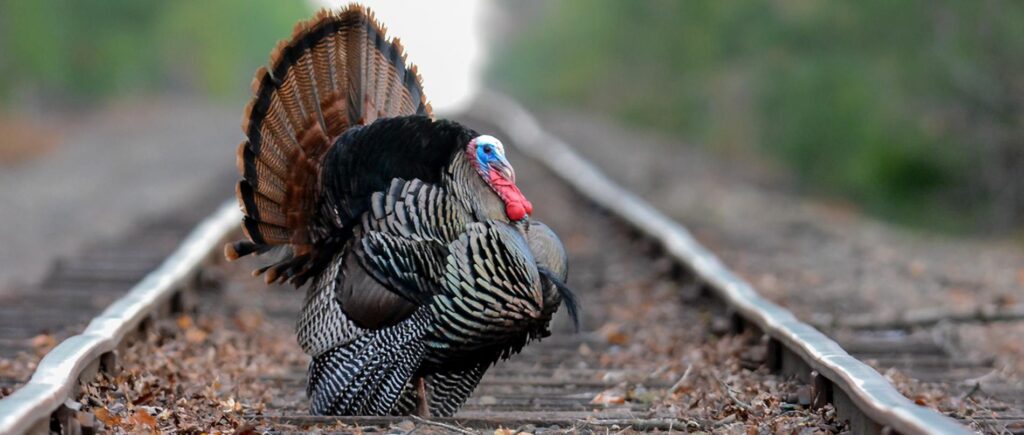
Description: The Wild Turkey (Meleagris gallopavo) is native to North American forests and woodlands. Males (toms or gobblers) are large with iridescent feathers, a bare head and neck, and a distinctive beard of feathers on their chest. They are known for their gobbling calls.
8. Order Phoenicopteriformes – Flamingos
General Characteristics: Flamingos are tall, wading birds famous for their bright pink plumage and uniquely shaped beaks used for filter-feeding. They live in large colonies near shallow lakes or lagoons.16 Surprisingly, genetic studies show they are closely related to grebes (Podicipediformes).16
Example: Greater Flamingo
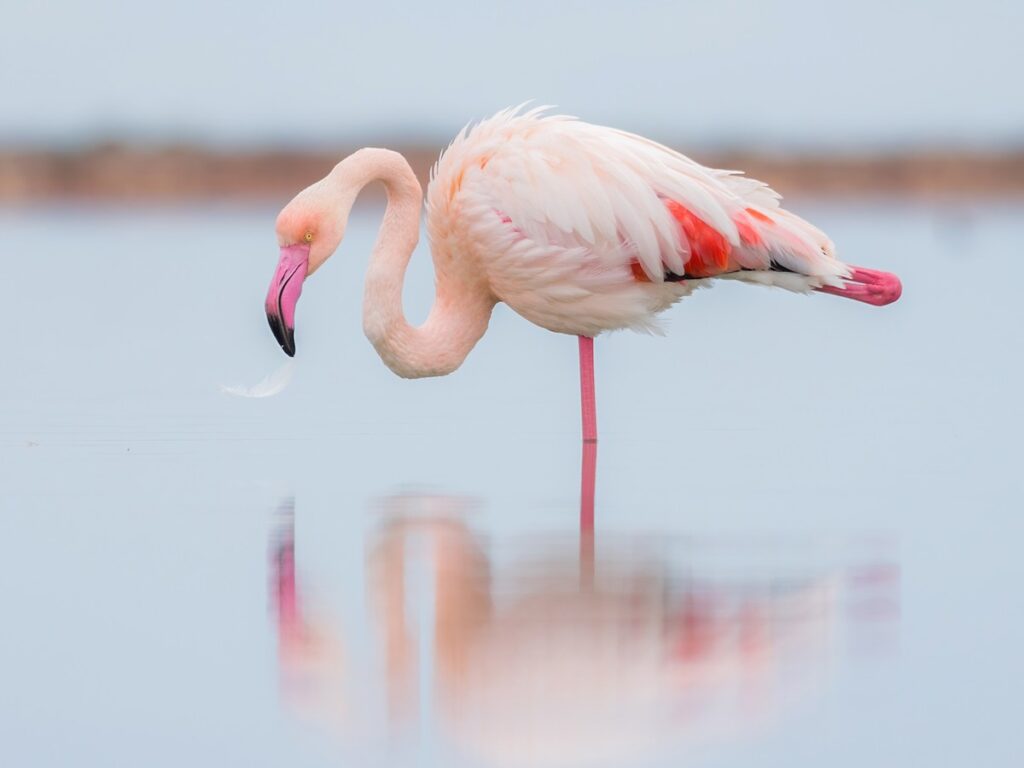
Description: The Greater Flamingo (Phoenicopterus roseus) is the most widespread flamingo species, found in parts of Africa, Asia, and southern Europe.17 They have pale pink plumage, long necks and legs, and feed by holding their specialized beak upside down in the water to filter out small shrimp and algae.
9. Order Podicipediformes – Grebes
General Characteristics: Grebes are expert diving birds found in freshwater lakes and ponds worldwide. They have lobed toes (not fully webbed), legs set far back on their bodies for efficient swimming underwater, and pointed bills for catching fish and aquatic invertebrates.16 They are closely related to flamingos.16
Example: Pied-billed Grebe
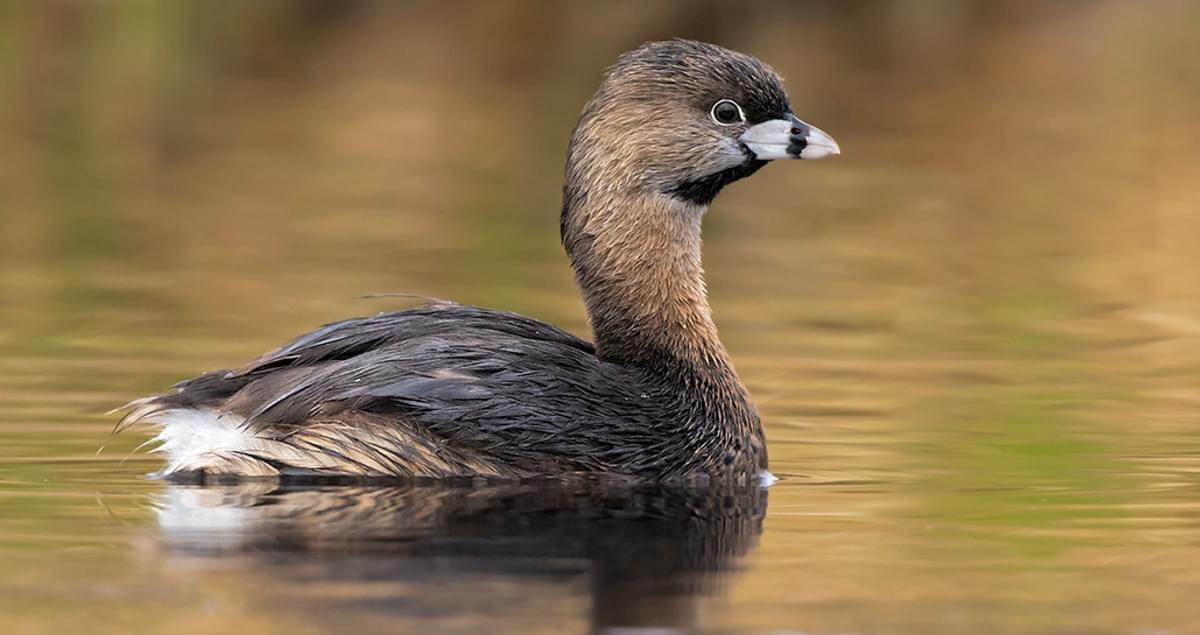
Description: The Pied-billed Grebe (Podilymbus podiceps) is a small, brownish grebe common across the Americas. It has a short, thick bill with a black ring during breeding season. They are known for their ability to sink slowly beneath the water’s surface without diving.
10. Order Columbiformes – Pigeons and Doves
General Characteristics: This large order includes pigeons and doves, found worldwide except in the coldest regions. They are typically stout-bodied birds with short necks, short slender bills, and soft plumage.16 They are known for drinking by sucking water directly, unlike most birds.
Example: Rock Pigeon
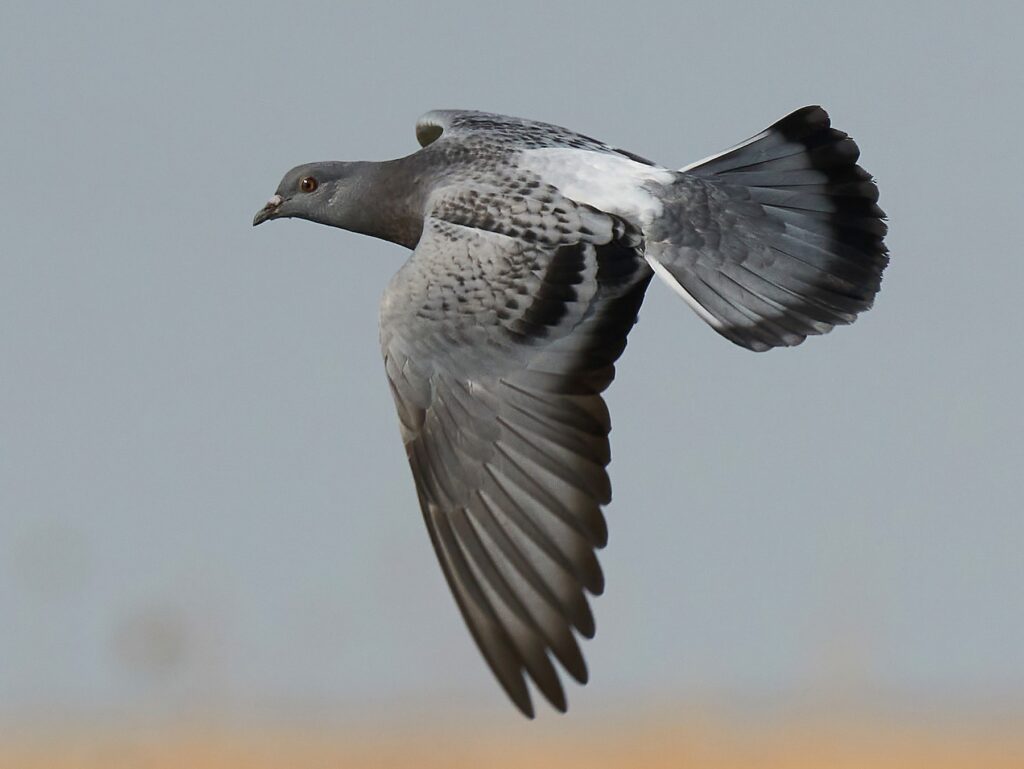
Description: The Rock Pigeon (Columba livia), often called the common pigeon, is found in cities and towns globally, originally native to cliffs in Europe, North Africa, and Asia.17 They come in various colors, often gray with iridescent neck feathers. They are adaptable and thrive in human environments.
11. Order Mesitornithiformes – Mesites
General Characteristics: Mesites are a small, unique family of near-flightless birds found only in Madagascar. They are ground-dwelling, living in forests or scrubland, and their evolutionary relationships were unclear for a long time.16 Recent studies suggest they are related to sandgrouse and pigeons.16 This is one of the orders with very few species.
Example: Subdesert Mesite
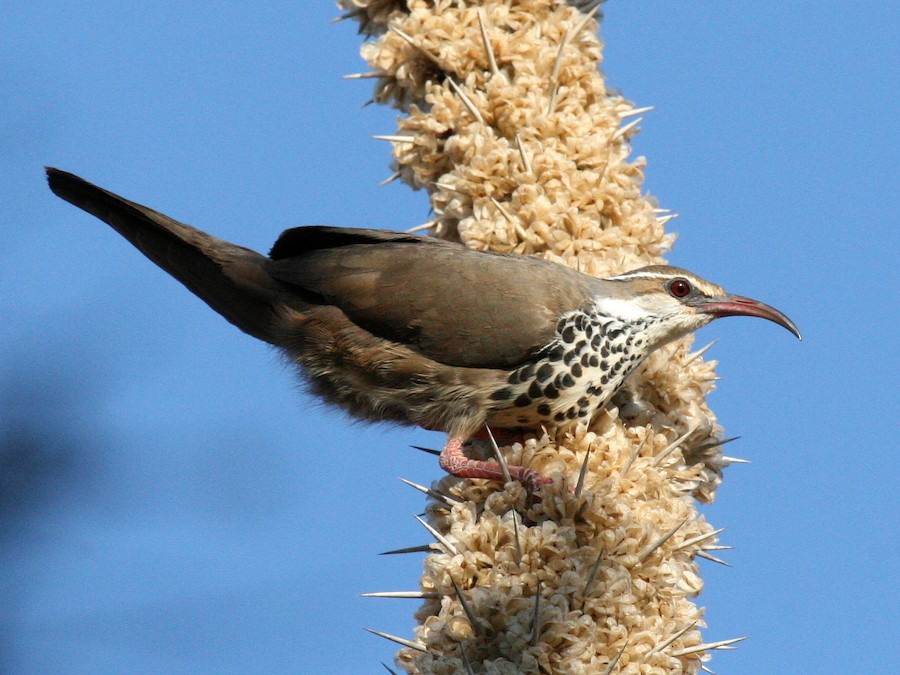
Description: The Subdesert Mesite (Monias benschi) lives in the spiny desert scrub of southwestern Madagascar.17 It has a long, downcurved bill and walks along the ground searching for insects and seeds. They live in small groups and make soft calls.
12. Order Pterocliformes – Sandgrouse
General Characteristics: Sandgrouse are medium-sized, ground-dwelling birds adapted to arid environments in Africa and Asia. They have pointed wings for fast flight and are known for the males’ ability to absorb water in their belly feathers and carry it back to their chicks.16 They are related to mesites and pigeons.16
Example: Chestnut-bellied Sandgrouse
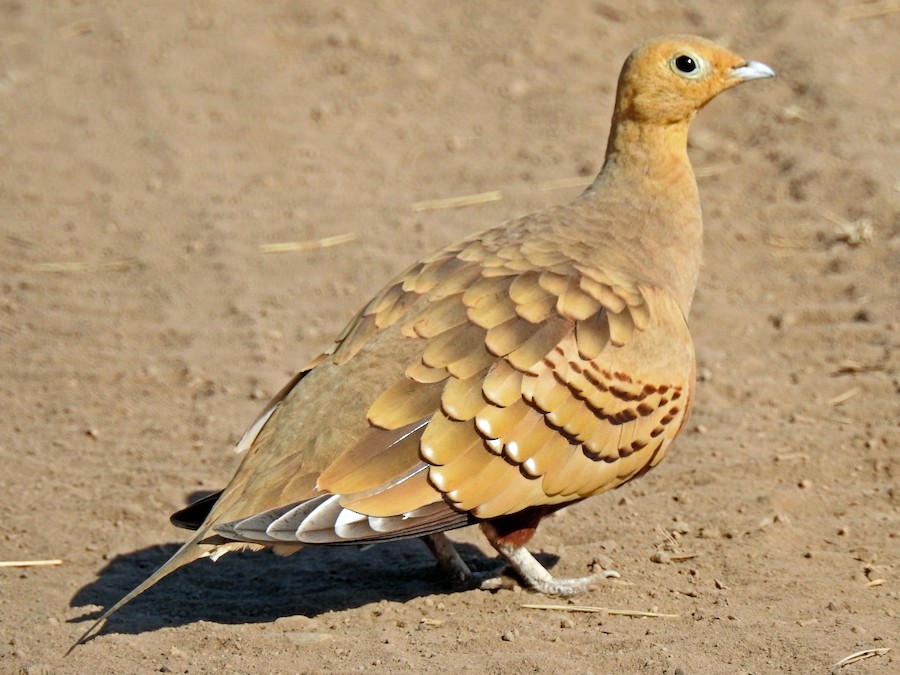
Description: The Chestnut-bellied Sandgrouse (Pterocles exustus) is found in dry, open areas across parts of Africa and South Asia. Males have a distinctive chestnut belly patch. They gather in large flocks at waterholes, especially in the morning.
13. Order Otidiformes – Bustards
General Characteristics: Bustards are large, terrestrial birds found in dry grasslands and steppes of the Old World (Europe, Asia, Africa) and Australia. They have long legs and necks, and many species perform spectacular courtship displays.16 They were once grouped with cranes but now form their own distinct order.
Example: Kori Bustard
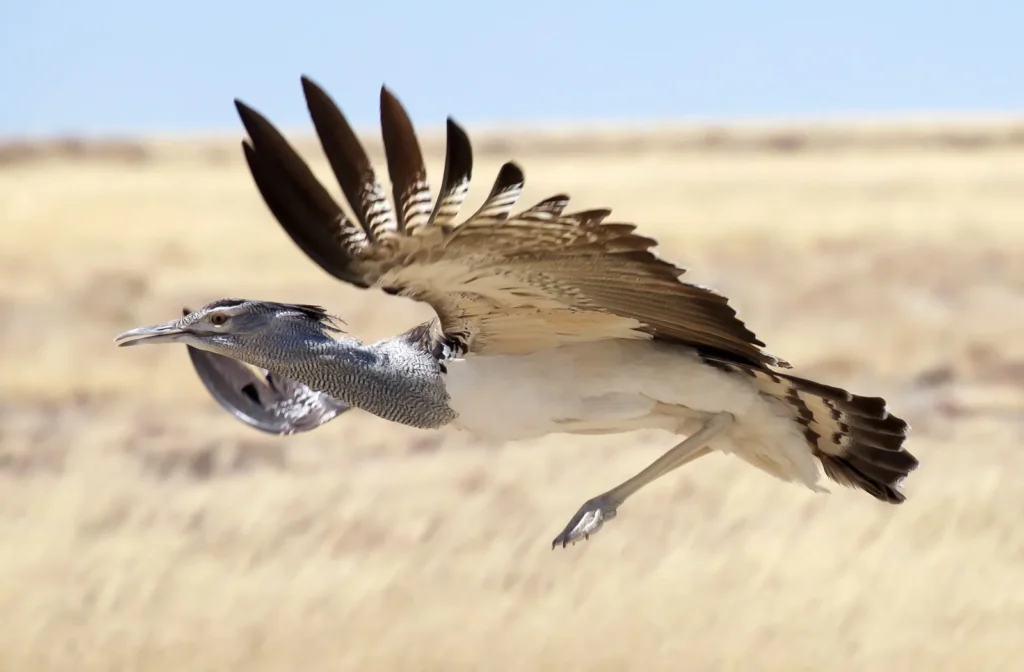
Description: The Kori Bustard (Ardeotis kori) is one of the heaviest flying birds, native to grasslands and savannas in eastern and southern Africa. It has a gray neck, brown patterned back, and walks slowly while foraging for insects, small reptiles, and plants. Males perform impressive displays, inflating their neck feathers.
14. Order Musophagiformes – Turacos
General Characteristics: Turacos, also known as loeries or go-away-birds, are colorful medium-sized birds found only in sub-Saharan Africa. They mostly live in forests and woodlands and have unique green and red pigments in their feathers.16 Many have prominent crests.
Example: Guinea Turaco
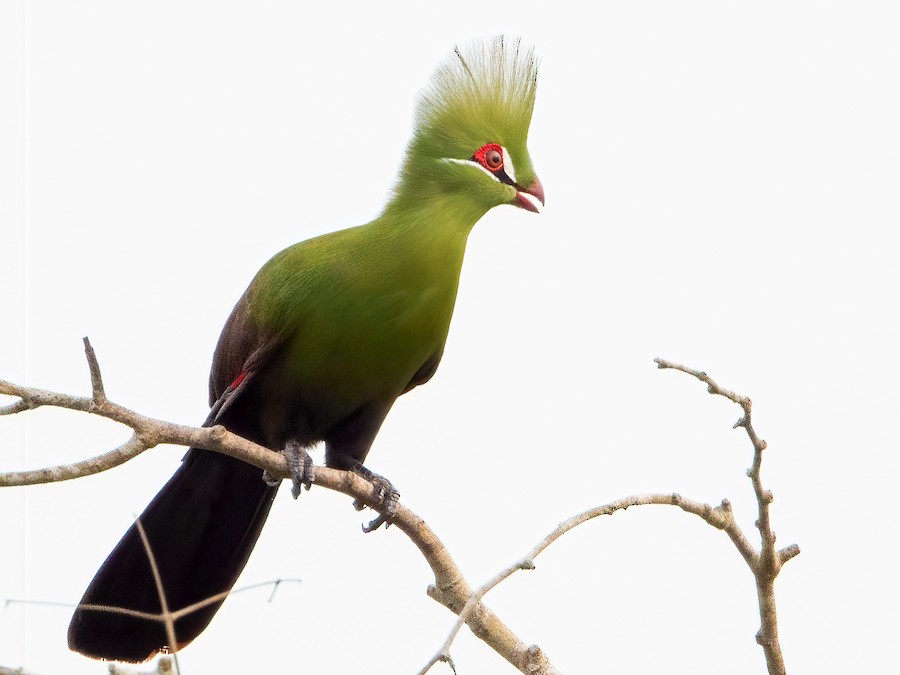
Description: The Guinea Turaco (Tauraco persa), also called the Green Turaco, inhabits forests across West and Central Africa.17 It has brilliant green plumage, a striking crest tipped with white, and bright crimson patches on its wings visible in flight. They mainly eat fruits.
15. Order Cuculiformes – Cuckoos
General Characteristics: Cuckoos are slender, medium-sized birds found worldwide, known for their distinctive calls. Many species are brood parasites, meaning they lay their eggs in the nests of other bird species, leaving the host parents to raise the cuckoo chick.16
Example: Common Cuckoo
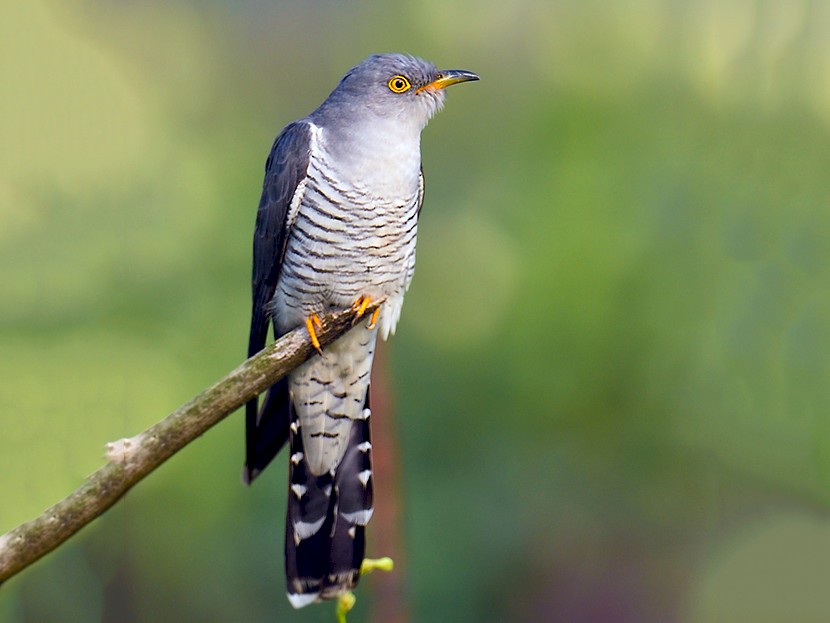
Description: The Common Cuckoo (Cuculus canorus) breeds across Europe and Asia and winters in Africa and southern Asia.17 Males are gray and resemble small hawks, making the famous “cuck-oo” call. Females lay their eggs in the nests of smaller songbirds.
16. Order Caprimulgiformes – Nightjars and Allies
General Characteristics: This order includes nocturnal or crepuscular (active at dawn and dusk) birds like nightjars, frogmouths, potoos, and the Oilbird. They typically have large mouths for catching insects in flight, cryptic camouflage plumage, and short legs.16 Some classifications also include swifts and hummingbirds in or near this order due to close evolutionary ties.16
Example: Common Nighthawk
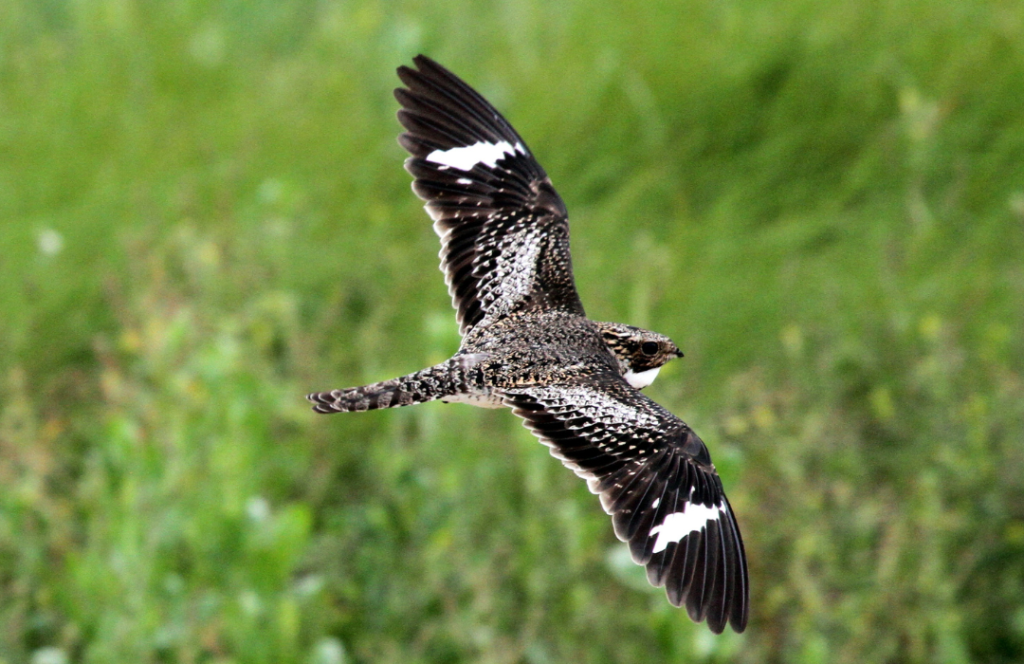
Description: The Common Nighthawk (Chordeiles minor) breeds across North and South America and winters in South America. Despite its name, it’s not a hawk but a nightjar relative, often seen flying erratically at dusk catching insects. It has long, pointed wings with a white bar visible in flight.
17. Order Apodiformes – Swifts and Hummingbirds
General Characteristics: This large order contains the incredibly fast-flying swifts and the tiny, hovering hummingbirds. They have small feet and long wings adapted for superb aerial agility.16 Swifts catch insects in flight, while hummingbirds feed on nectar using long bills and hovering flight. This group is closely related to the nightjars (Caprimulgiformes).16
Example: Ruby-throated Hummingbird
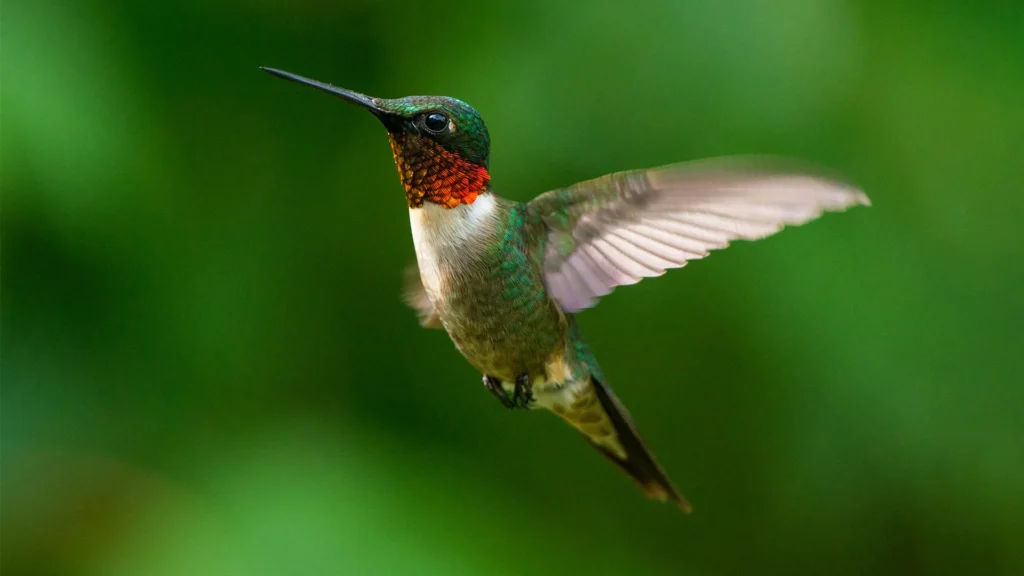
Description: The Ruby-throated Hummingbird (Archilochus colubris) breeds in eastern North America and winters in Central America. Males have a brilliant iridescent red throat (gorget) and green back. They are masters of flight, able to hover, fly backwards, and beat their wings incredibly fast.
18. Order Opisthocomiformes – Hoatzin
General Characteristics: This order contains only one species, the Hoatzin, a very unusual bird found in swamps and mangroves of the Amazon and Orinoco basins in South America.16 It’s known for eating leaves and having claws on its wings when young, which help it climb. Its evolutionary relationships are still debated, making it a unique and ancient lineage.16 This is another example of an order with very low species diversity.
Example: Hoatzin
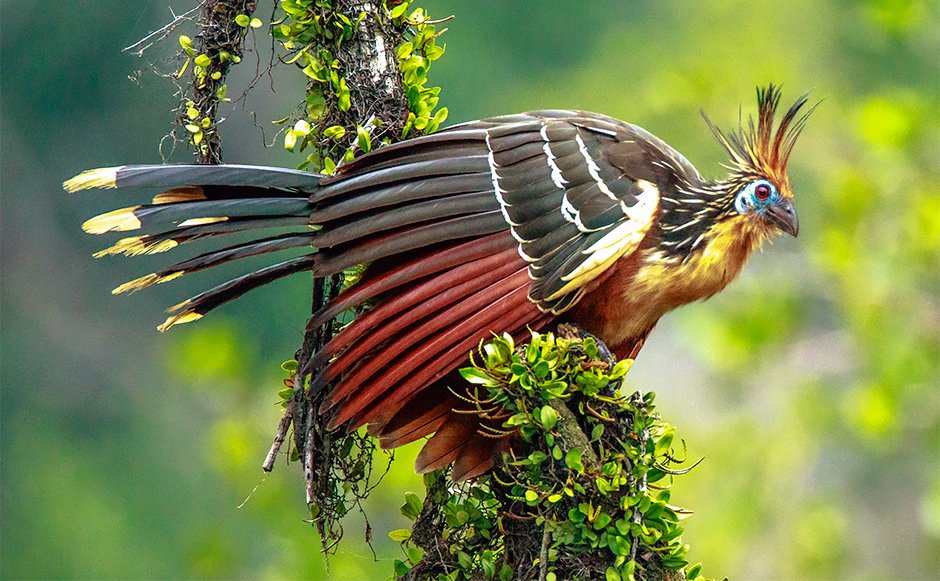
Description: The Hoatzin (Opisthocomus hoazin) is a pheasant-sized bird with a blue bare face, red eyes, and a spiky crest.17 It digests leaves using bacterial fermentation in an enlarged crop, similar to cows, which can give it a manure-like odor. Chicks use wing claws to clamber through vegetation near water.
19. Order Gruiformes – Cranes, Rails, and Allies
General Characteristics: This is a diverse order of terrestrial and marsh birds, including cranes, rails, coots, flufftails, finfoots, limpkin, and trumpeters. While varied in appearance, many live near water and have long legs or toes adapted for walking on soft ground or vegetation.16 The group used to be larger, but some unrelated birds have been moved to other orders.16
Example: Sandhill Crane
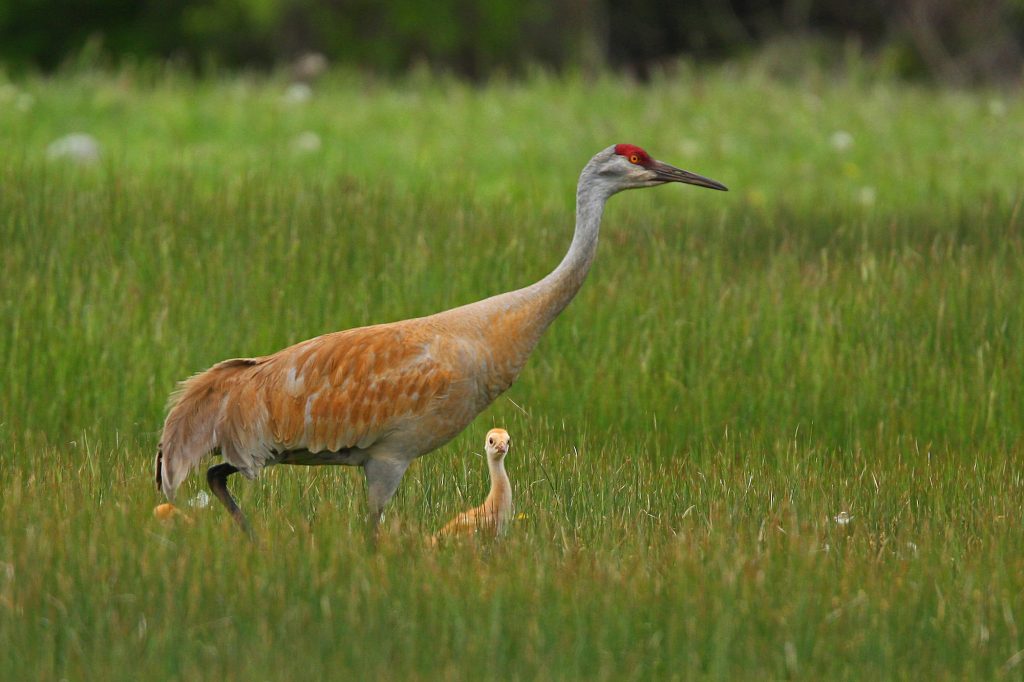
Description: The Sandhill Crane (Antigone canadensis) is a large, tall gray bird with a red patch on its forehead, found across North America and Siberia. They inhabit wetlands and grasslands and are known for their loud, bugling calls and elaborate dancing courtship displays. They often migrate in huge flocks.
20. Order Charadriiformes – Shorebirds, Gulls, and Auks
General Characteristics: This is a very large and diverse order containing shorebirds (like plovers and sandpipers), gulls, terns, skimmers, skuas, and auks (like puffins and murres). Most live near water (coasts, lakes, rivers) and feed on invertebrates or fish, but their appearances and lifestyles vary greatly.16 This order represents a major, ancient radiation of water-associated birds.16
Example: Killdeer
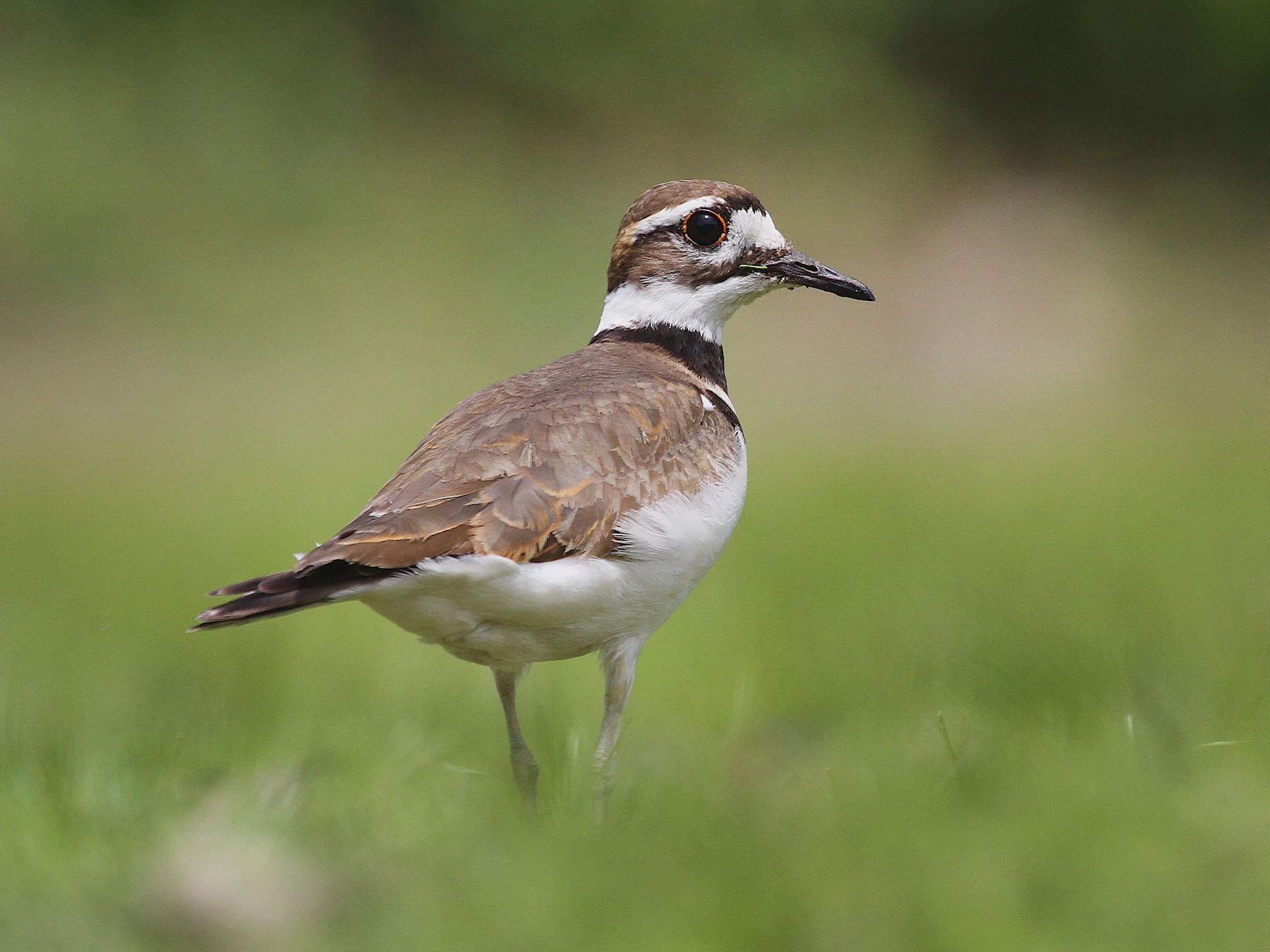
Description: The Killdeer (Charadrius vociferus) is a common plover found in open country, often far from water, across North and South America. It has two distinctive black bands across its white chest and is known for its loud “kill-deer” call and its broken-wing display used to lure predators away from its nest.
21. Order Eurypygiformes – Kagu and Sunbittern
General Characteristics: This small order contains only two species: the Kagu from New Caledonia and the Sunbittern from Central and South America. Though geographically separated, genetic evidence shows they are each other’s closest relatives.17 They are elegant, medium-sized birds living near water or on forest floors.
Example: Sunbittern
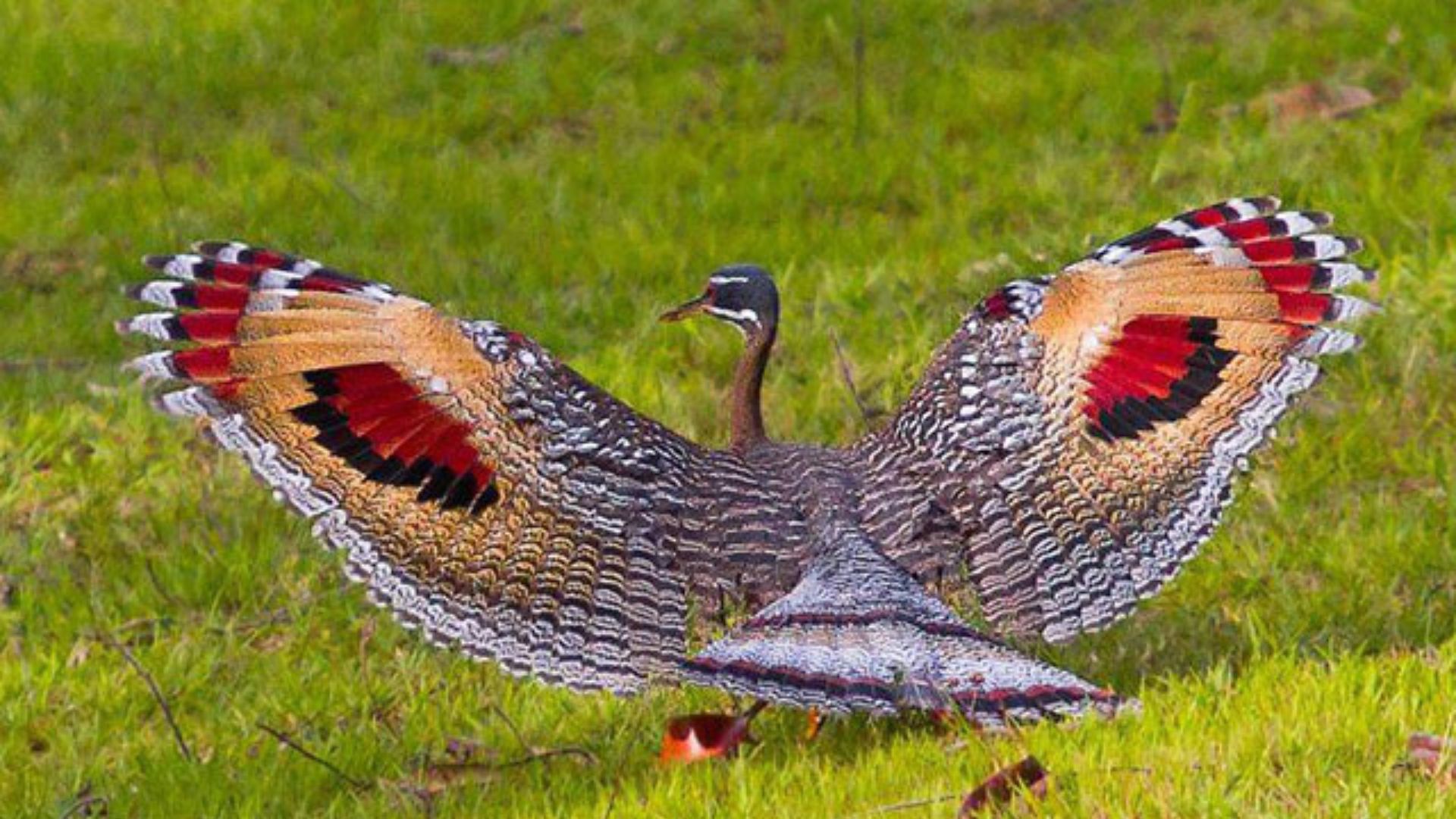
Description: The Sunbittern (Eurypyga helias) lives along forested streams and rivers in tropical Central and South America.17 It has intricate brown, gray, and black plumage, but when it opens its wings, it reveals stunning “sunburst” patterns of orange, yellow, and black, used in displays.
22. Order Phaethontiformes – Tropicbirds
General Characteristics: Tropicbirds are sleek, white seabirds found over tropical oceans worldwide. They are known for their two extremely long central tail feathers (streamers) and pointed bills used for plunge-diving to catch fish and squid.17 They nest on remote oceanic islands.
Example: Red-billed Tropicbird
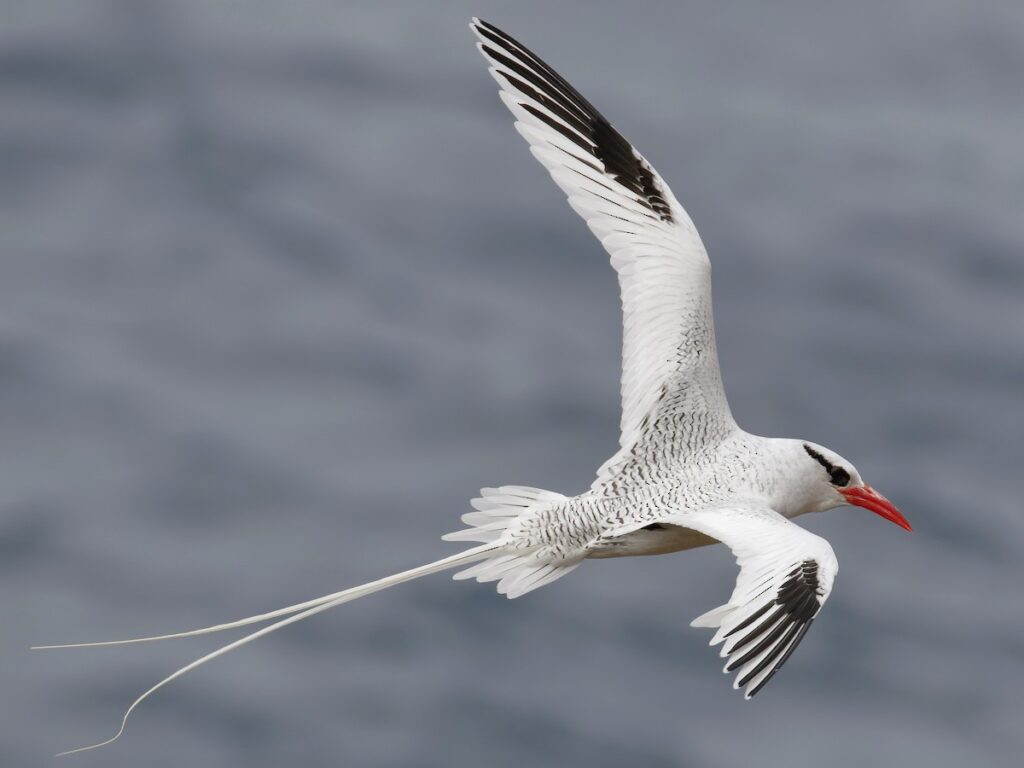
Description: The Red-billed Tropicbird (Phaethon aethereus) has mostly white plumage, black eye stripes, a bright red bill, and long white tail streamers.17 It flies gracefully over tropical waters, occasionally diving from height to catch prey near the surface.
23. Order Gaviiformes – Loons (Divers)
General Characteristics: Loons (called divers in Europe) are large diving birds found in North America and Eurasia. They are superb swimmers and divers, with legs placed far back on their bodies, solid bones (unlike most birds), and dagger-like bills for catching fish.17 They are awkward on land and need a long water runway to take off.
Example: Common Loon
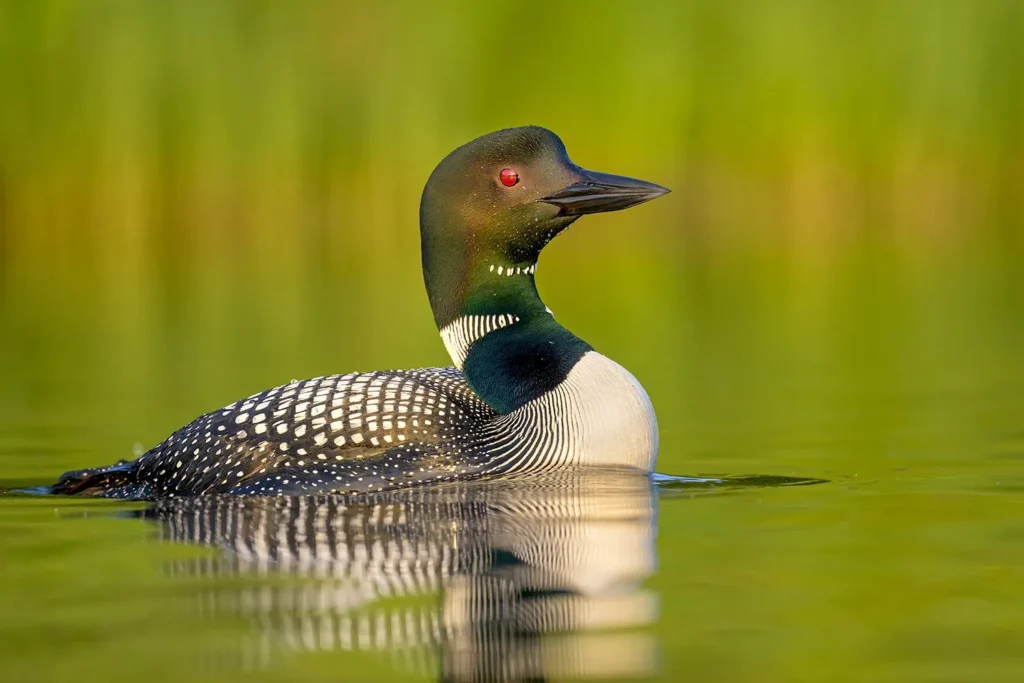
Description: The Common Loon (Gavia immer) breeds on northern lakes and winters along coasts. It has striking black-and-white checkered plumage and a black head in summer, with haunting, yodeling calls. They are powerful underwater swimmers, pursuing fish with ease.
24. Order Sphenisciformes – Penguins
General Characteristics: Penguins are flightless seabirds highly adapted for life in the water, found almost exclusively in the Southern Hemisphere. They have dense, waterproof feathers, wings modified into flippers for swimming, and use their feet for steering underwater.17 They stand upright on land.
Example: Emperor Penguin
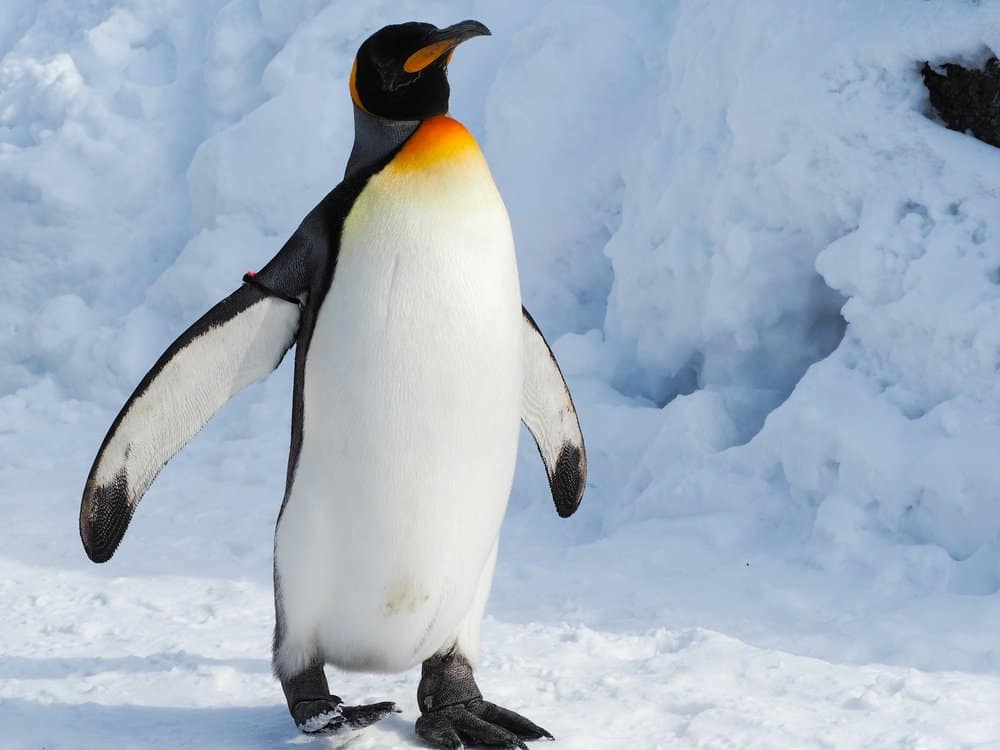
Description: The Emperor Penguin (Aptenodytes forsteri) is the tallest and heaviest penguin, famous for breeding during the harsh Antarctic winter. They have black backs, white bellies, and yellow-orange patches on their necks. Males incubate a single egg on their feet through the extreme cold.
25. Order Procellariiformes – Tubenoses
General Characteristics: This order includes albatrosses, shearwaters, petrels, and storm petrels – seabirds that spend most of their lives over the open ocean. They have tube-shaped nostrils on their beaks (hence “tubenoses”), which help excrete salt and may enhance their sense of smell for finding food.17 Many have long, narrow wings for efficient gliding.
Example: Wandering Albatross
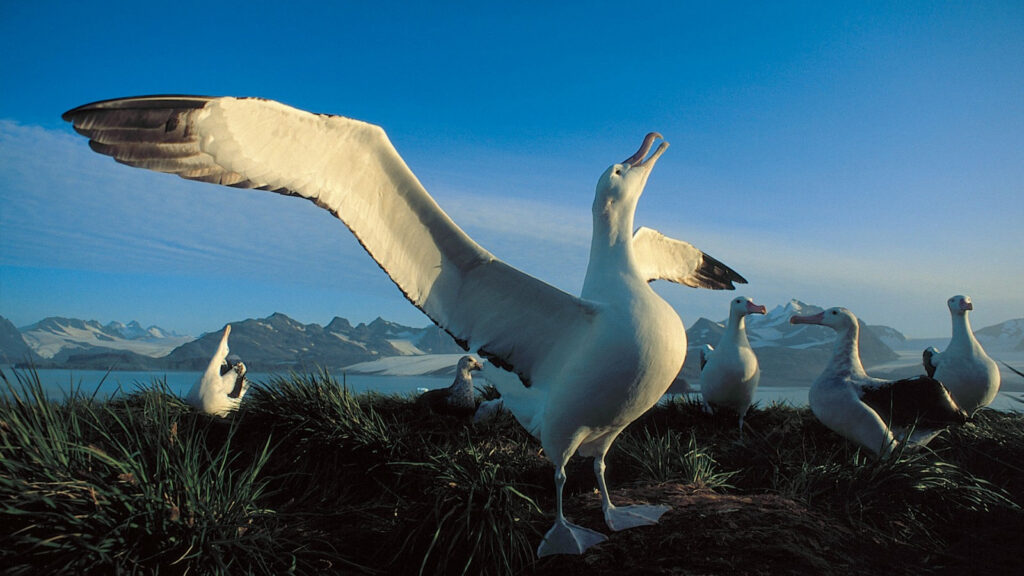
Description: The Wandering Albatross (Diomedea exulans) has the largest wingspan of any living bird, reaching up to 11 feet (3.5 meters). They soar effortlessly over the Southern Ocean, feeding on squid and fish near the surface. They nest on remote subantarctic islands.
26. Order Ciconiiformes – Storks
General Characteristics: Storks are large, long-legged, long-necked wading birds with large, stout bills. They are found worldwide, often near wetlands, and typically fly with their necks outstretched (unlike herons).17 This order used to include herons and ibises, but genetic data showed they belong elsewhere.
Example: White Stork
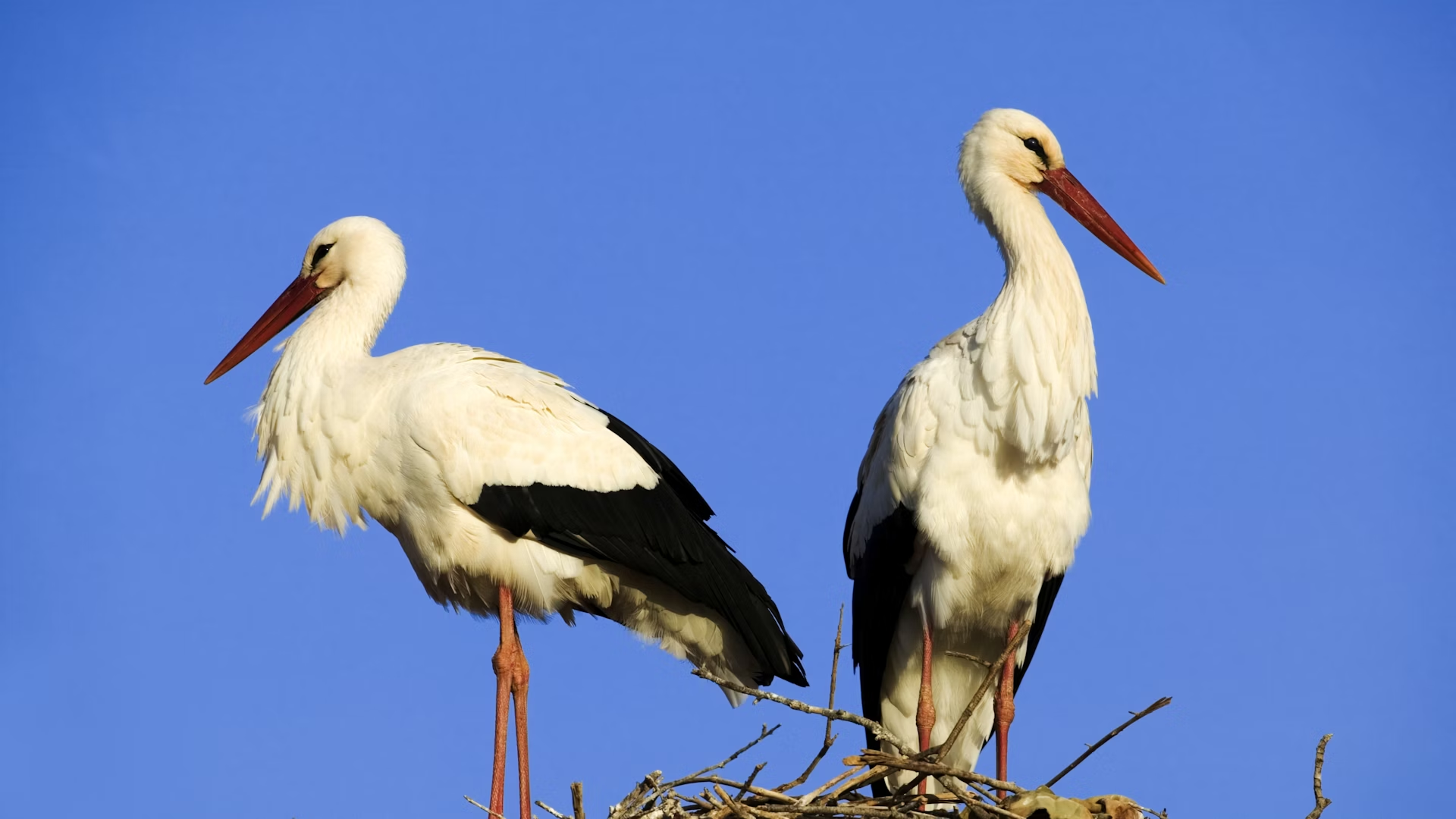
Description: The White Stork (Ciconia ciconia) is a large white bird with black wing feathers and red legs and bill, breeding in Europe, northwestern Africa, and southwestern Asia, wintering mainly in Africa.17 They are famous for nesting on rooftops and chimneys in Europe and migrating in large flocks.
27. Order Suliformes – Gannets, Boobies, Cormorants, and Frigatebirds
General Characteristics: This order brings together several groups of coastal and marine birds, including gannets, boobies, cormorants, anhingas, and frigatebirds. Many are expert fishers, often plunge-diving or swimming underwater to catch prey. They typically have totipalmate feet (all four toes webbed together).17
Example: Brown Booby
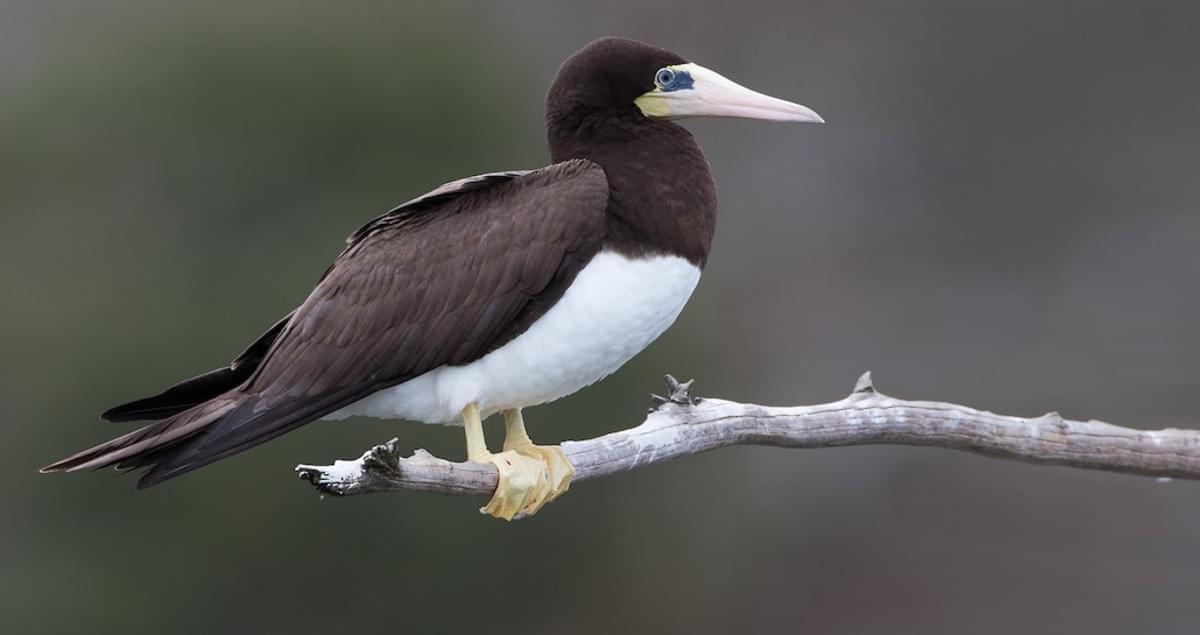
Description: The Brown Booby (Sula leucogaster) is a seabird found in tropical oceans worldwide. Adults have dark brown upperparts and wings, a sharply defined white belly, and a pale bill and feet.17 They are agile fliers and plunge-dive from height to catch fish.
28. Order Pelecaniformes – Pelicans, Herons, Ibises, and Allies
General Characteristics: This diverse order includes pelicans, herons, egrets, bitterns, ibises, and spoonbills. Most are medium to large water birds with long legs and necks, associated with wetlands, coasts, and lakes.17 Pelicans are unique with their throat pouches, while herons often hunt by standing still or wading slowly.
Example: Brown Pelican
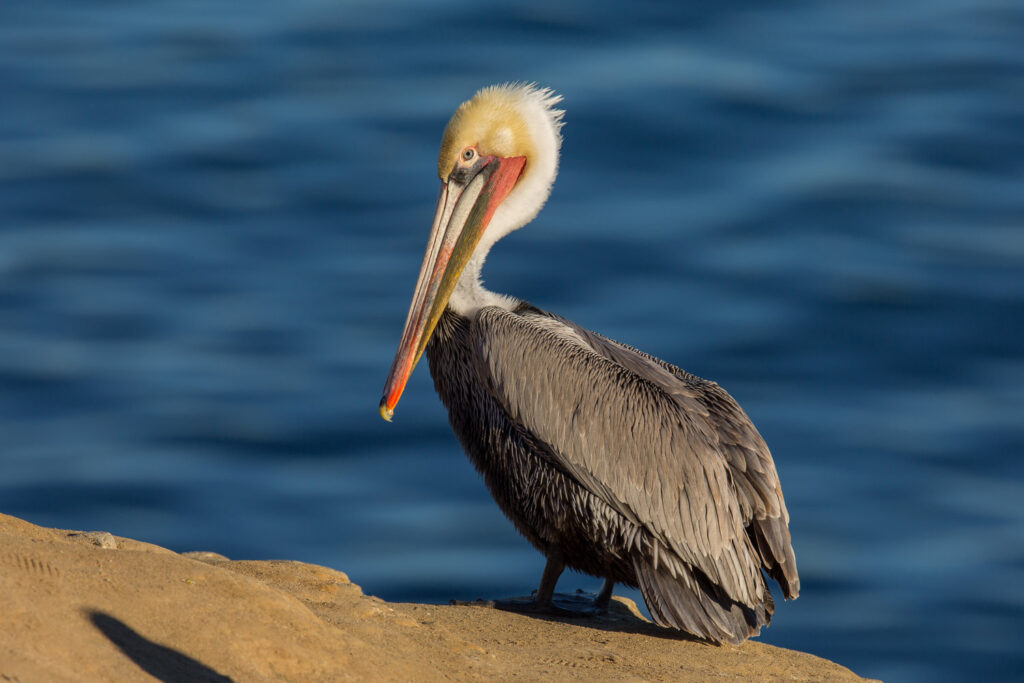
Description: The Brown Pelican (Pelecanus occidentalis) is found along coasts of the Americas. It’s known for its large throat pouch used to scoop up fish and drain water. They fly in lines low over the water and perform spectacular head-first dives to catch prey.
29. Order Cathartiformes – New World Vultures
General Characteristics: This order contains the vultures and condors found only in the Americas (the New World). They are large scavenging birds with broad wings for soaring and keen eyesight for spotting carcasses.17 Unlike Old World vultures (related to hawks and eagles), they lack strong talons and rely on hooked beaks to tear flesh.
Example: Turkey Vulture
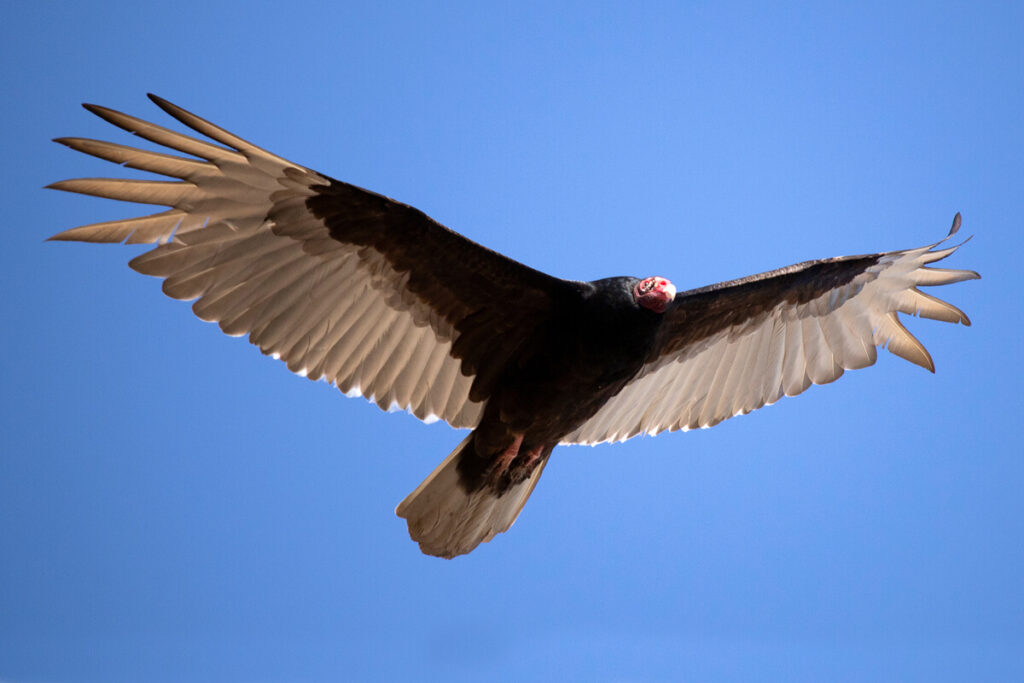
Description: The Turkey Vulture (Cathartes aura) is widespread across the Americas.17 It has dark brown plumage, a featherless red head (in adults), and holds its wings in a slight V-shape (dihedral) while soaring. They have an excellent sense of smell, unusual for birds, which helps them find carrion.
30. Order Accipitriformes – Hawks, Eagles, and Old World Vultures
General Characteristics: This large order includes most birds of prey, such as hawks, eagles, kites, harriers, buzzards, and the vultures found in Africa, Asia, and Europe (Old World Vultures). They typically have strong hooked beaks, sharp talons, and excellent eyesight for hunting live prey or scavenging.17 By the way, if you want to learn how to tell the difference between eagles and hawks, check out our post on it.
Example: Bald Eagle
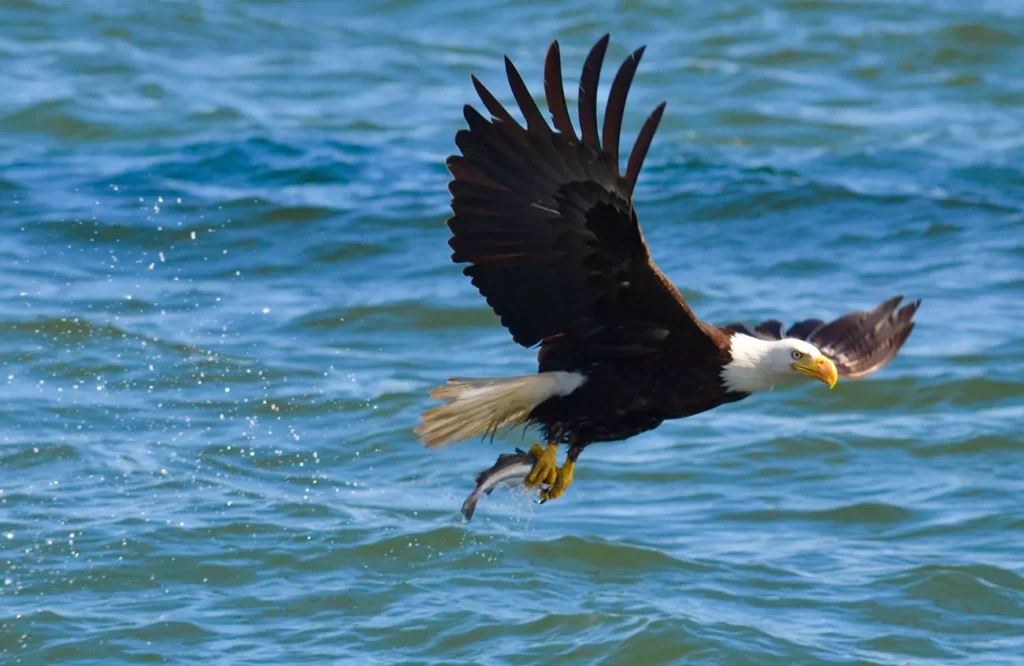
Description: The Bald Eagle (Haliaeetus leucocephalus) is the national bird of the United States, found across North America near large bodies of water.17 Adults have a distinctive white head and tail, dark brown body, and a large yellow beak. They primarily eat fish, often snatching them from the water’s surface.
31. Order Strigiformes – Owls
General Characteristics: Owls are nocturnal or crepuscular birds of prey found worldwide. They have large forward-facing eyes providing binocular vision, exceptional hearing often aided by facial discs, hooked beaks, sharp talons, and feathers adapted for silent flight.17
Example: Great Horned Owl
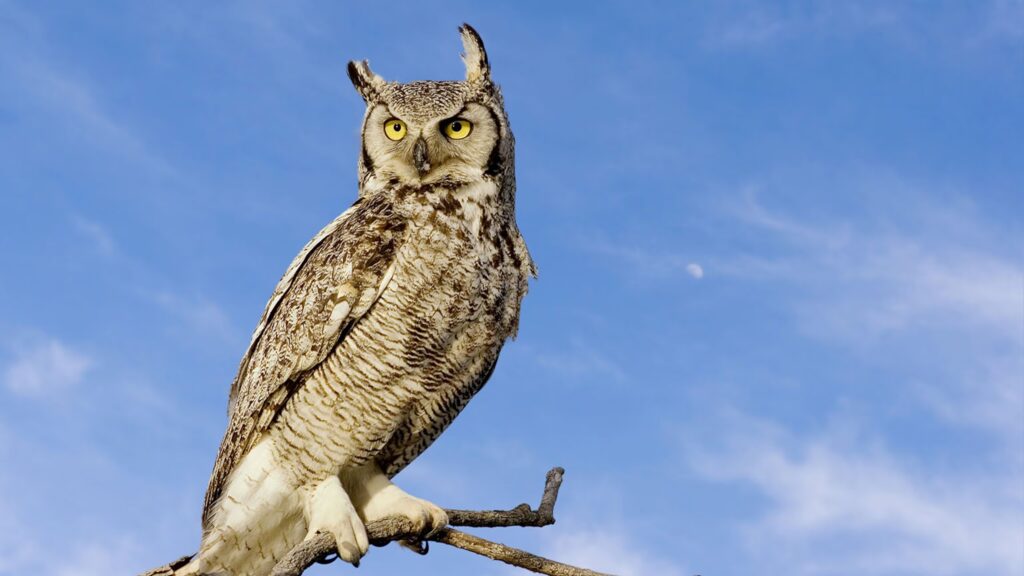
Description: The Great Horned Owl (Bubo virginianus) is a large, powerful owl found throughout the Americas. It has prominent ear tufts (“horns”), yellow eyes, and mottled gray-brown plumage for camouflage.17 They are adaptable predators, hunting mammals, birds, and reptiles in various habitats.
32. Order Coliiformes – Mousebirds
General Characteristics: Mousebirds are small, slender birds found only in sub-Saharan Africa. They have dull brownish or grayish plumage, crests, long tails, and unique feet where all four toes can point forward, allowing them to scurry through vegetation like rodents (hence “mousebird”).17 They often hang upside down while feeding.
Example: Speckled Mousebird
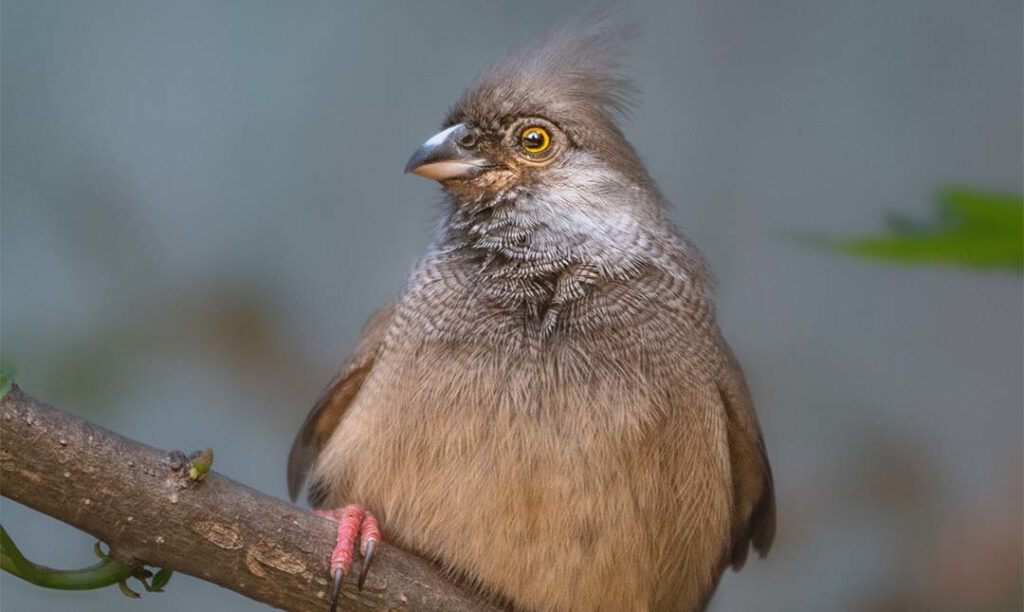
Description: The Speckled Mousebird (Colius striatus) is the largest and most common mousebird, found in various habitats across eastern and southern Africa.17 It has barred brownish plumage, a crest, and a long tail. They live in social groups and feed on fruits, leaves, and nectar.
33. Order Leptosomiformes – Cuckoo-roller
General Characteristics: This order contains only one species, the Cuckoo-roller, found in Madagascar and the Comoro Islands. It’s a medium-sized bird with unique features, and its evolutionary placement was long uncertain.17 It is not closely related to either cuckoos or rollers.
Example: Cuckoo-roller
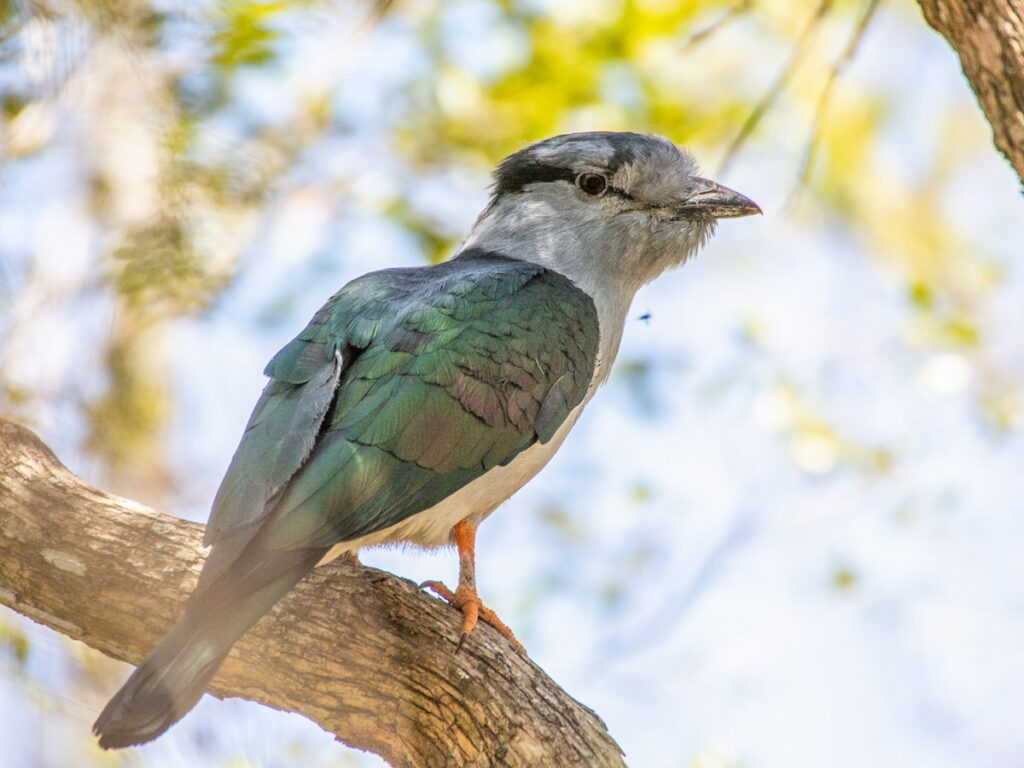
Description: The Cuckoo-roller (Leptosomus discolor) lives in forests and woodlands.17 Males are iridescent green and gray, while females are reddish-brown and spotted. They have a stout bill and often perch upright, hunting insects and chameleons.
34. Order Trogoniformes – Trogons and Quetzals
General Characteristics: Trogons and quetzals are colorful birds found in tropical forests worldwide, with the greatest diversity in the Americas. They have soft, often iridescent plumage, short broad bills, and unique feet where the first and second toes point backward (heterodactyl).17 They often perch motionless before sallying out to catch insects or pluck fruit.
Example: Resplendent Quetzal
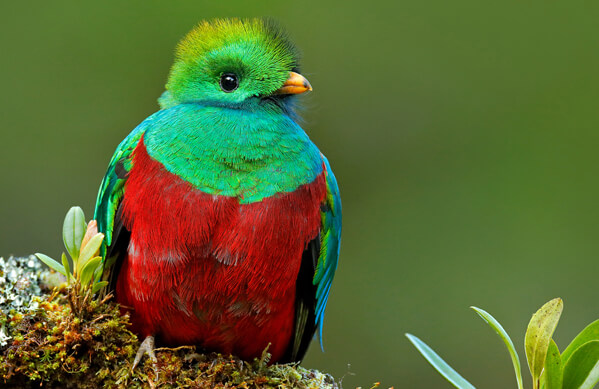
Description: The Resplendent Quetzal (Pharomachrus mocinno) is famed for its beauty, found in cloud forests of Central America.17 Males have brilliant emerald green upperparts, a crimson belly, and incredibly long, streaming upper tail coverts. They primarily eat fruits, especially wild avocados.
35. Order Bucerotiformes – Hornbills, Hoopoes, and Woodhoopoes
General Characteristics: This order includes hornbills (known for large, often colorful bills, sometimes with a casque), hoopoes (with crests and long curved bills), and woodhoopoes (slender, often iridescent birds). They are found in the Old World (Africa, Asia, Europe).17 Hornbills often have unusual nesting habits where the female is sealed inside a tree cavity.
Example: Great Hornbill
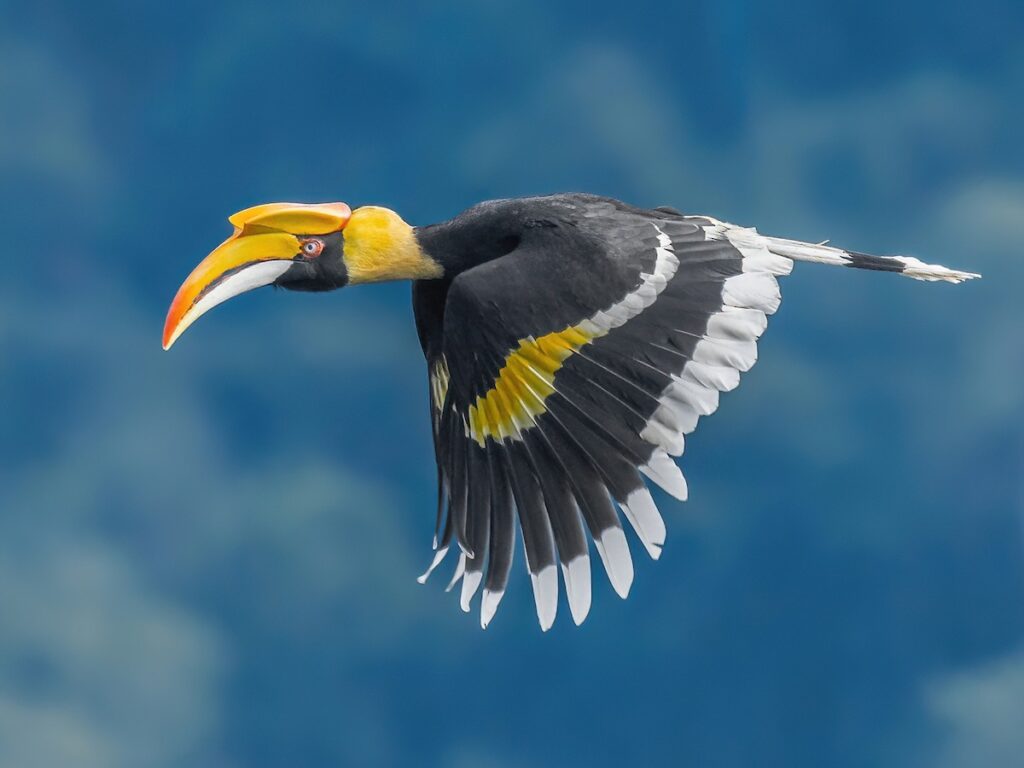
Description: The Great Hornbill (Buceros bicornis) is one of the largest hornbills, found in forests of South and Southeast Asia. It has striking black and white plumage, a massive yellow bill topped with a large casque (bony structure).17 They mainly eat fruit but also take insects and small animals.
36. Order Coraciiformes – Kingfishers, Rollers, Bee-eaters, and Motmots
General Characteristics: This is a colorful order of mostly carnivorous birds, including kingfishers (often near water with dagger-like bills), rollers (perform aerial acrobatics), bee-eaters (catch insects in flight), and motmots (with racket-tipped tails). Many have syndactyl feet (two front toes fused partly together).17
Example: Belted Kingfisher
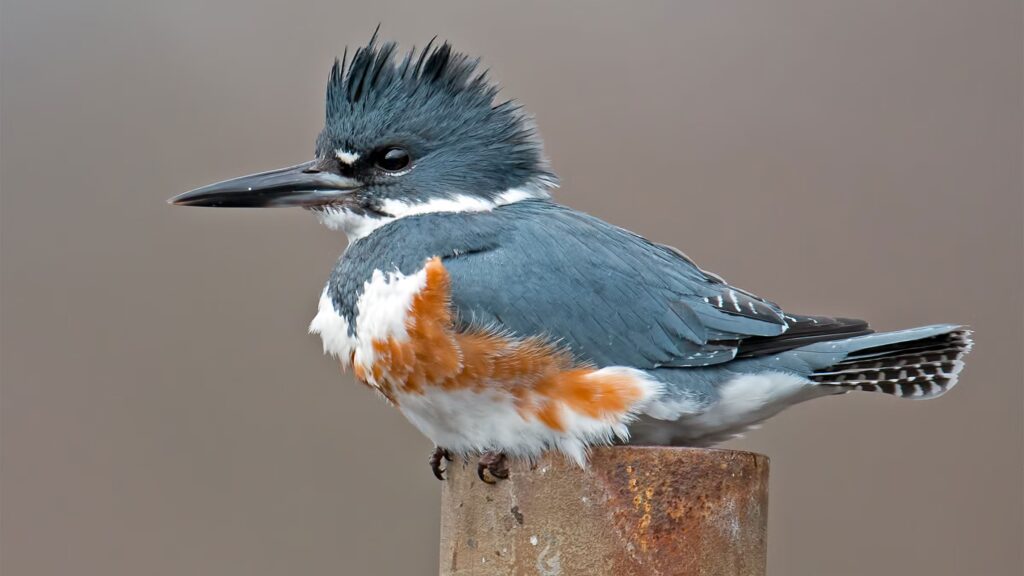
Description: The Belted Kingfisher (Megaceryle alcyon) is a common kingfisher across North America, found along rivers, lakes, and coasts.17 It has a large head with a shaggy crest, a strong pointed bill, blue-gray upperparts, and a white belly with a blue-gray breast band (females also have a rusty band). They dive headfirst into water to catch fish.
37. Order Galbuliformes – Jacamars and Puffbirds
General Characteristics: This order contains jacamars and puffbirds, found in tropical forests of Central and South America. Jacamars are slender, iridescent birds resembling large hummingbirds or bee-eaters, catching insects in flight. Puffbirds are stockier, sit-and-wait predators with large heads and heavy bills.17
Example: Rufous-tailed Jacamar
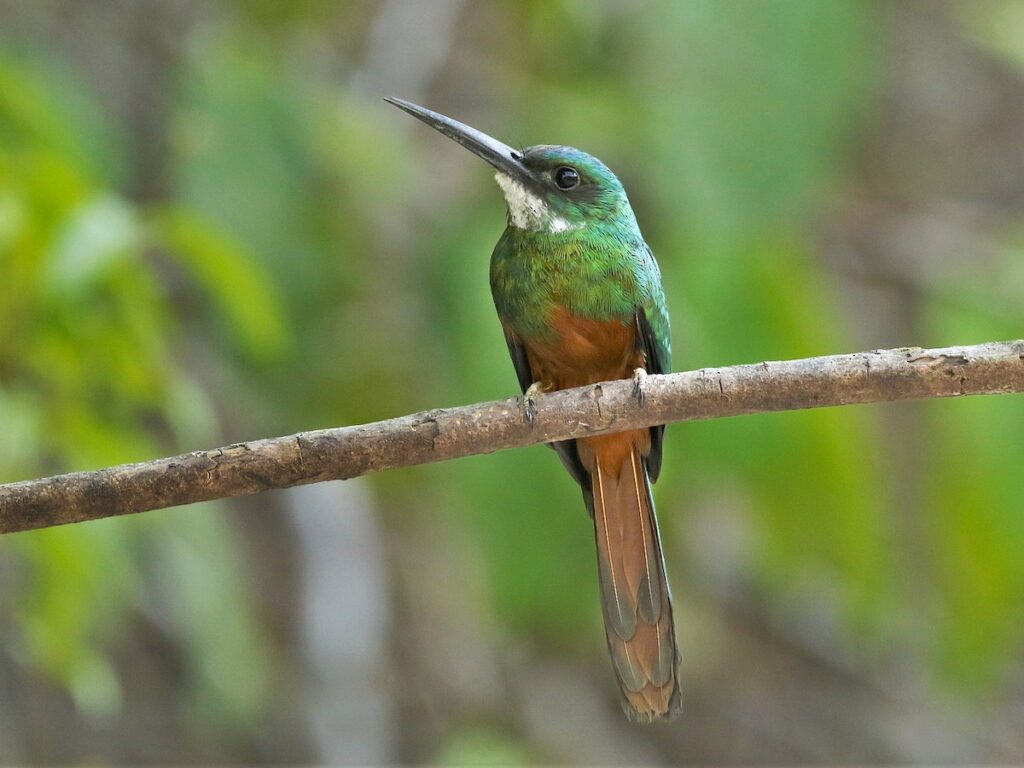
Description: The Rufous-tailed Jacamar (Galbula ruficauda) is widespread in forests and woodlands from Mexico to southern Brazil.17 It has glittering green upperparts, a rufous (reddish-brown) belly and tail, and a long, pointed black bill. They perch on branches, sallying out to snatch butterflies and other flying insects.
38. Order Piciformes – Woodpeckers, Toucans, Barbets, and Honeyguides
General Characteristics: This diverse order includes woodpeckers (adapted for drilling into wood), toucans and barbets (with large, often colorful bills), and honeyguides (known for guiding humans or animals to bees’ nests). They have zygodactyl feet (two toes forward, two toes back), useful for climbing or perching.17
Example: Downy Woodpecker
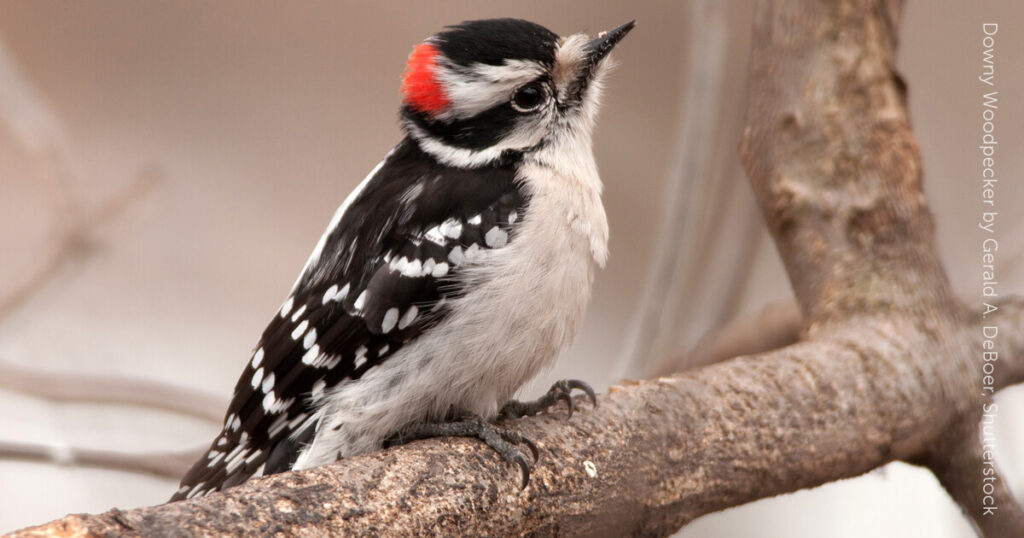
Description: The Downy Woodpecker (Dryobates pubescens) is North America’s smallest woodpecker, common in woodlands, parks, and backyards.17 It has black and white checkered plumage, a white stripe down the back, and males have a small red patch on the back of the head. They forage on trees, probing bark for insects.
39. Order Cariamiformes – Seriemas
General Characteristics: This small order contains only two species of seriemas, large terrestrial birds found in open grasslands and woodlands of South America. They look somewhat like long-legged secretarybirds or cranes, have long crest feathers, and are among the few birds known to kill snake prey by beating it against the ground.17
Example: Red-legged Seriema
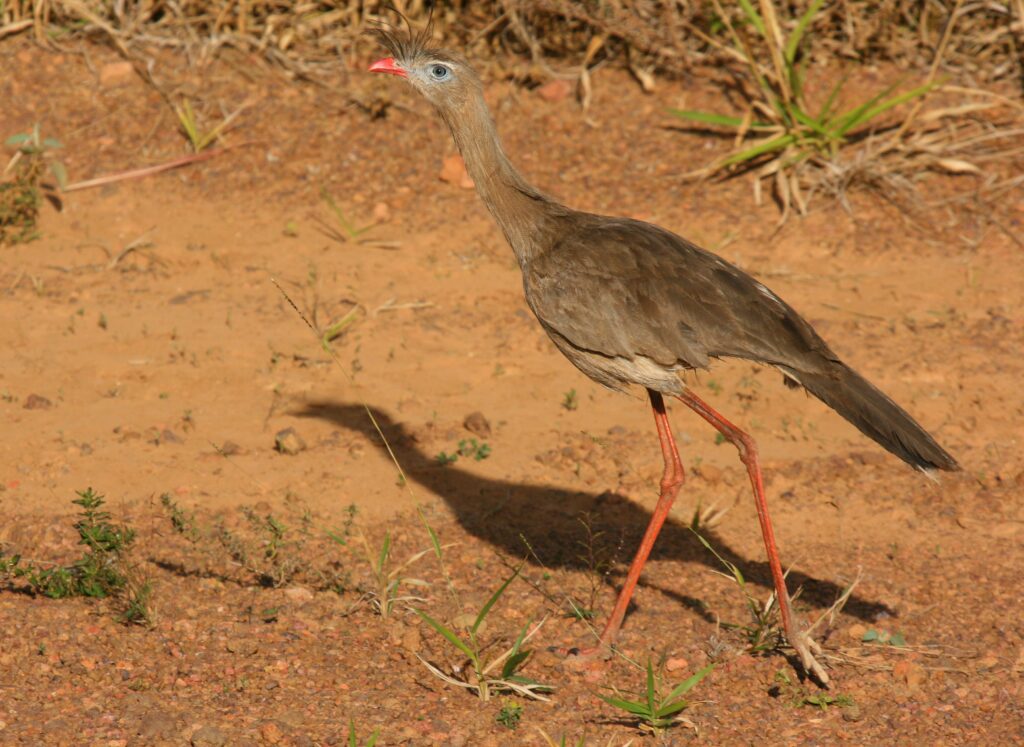
Description: The Red-legged Seriema (Cariama cristata) inhabits grasslands and scrub forests in central and eastern South America.17 It has mostly grayish-brown plumage, long red legs, a prominent crest at the base of its bill, and makes loud, yelping calls. They walk along the ground hunting insects, snakes, and rodents.
40. Order Falconiformes – Falcons and Caracaras
General Characteristics: This order includes falcons and caracaras, fast-flying birds of prey found worldwide. Falcons are known for their pointed wings, incredible speed (especially in dives), and notched beaks used to dispatch prey. Caracaras are generally slower, more terrestrial, and often scavenge.17 This group was once included with hawks and eagles (Accipitriformes), but genetic data shows they are surprisingly more closely related to parrots and songbirds.
Example: Peregrine Falcon
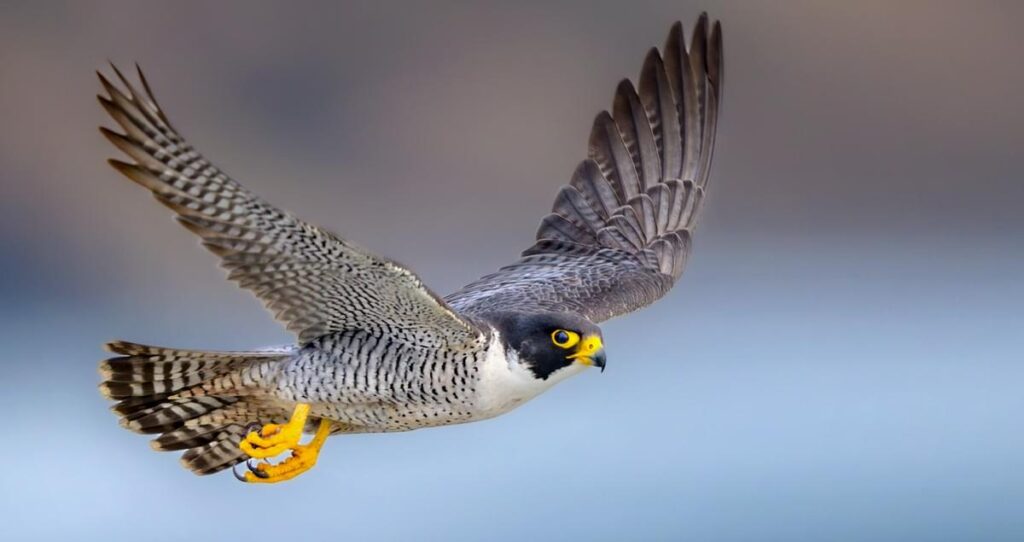
Description: The Peregrine Falcon (Falco peregrinus) is renowned for being the fastest animal on Earth, reaching speeds over 200 mph (320 km/h) during its hunting dives (stoops).17 It’s found globally, typically nesting on cliffs or tall structures, and preys mainly on other birds caught in mid-air. Adults have blue-gray backs, barred underparts, and a dark “helmet” pattern on their heads.
41. Order Psittaciformes – Parrots
General Characteristics: Parrots are a large, diverse order of often brightly colored birds found mainly in tropical and subtropical regions. They are known for their strong, hooked beaks used for cracking seeds and nuts, zygodactyl feet (two toes forward, two back) for climbing and holding food, and high intelligence, including the ability of some species to mimic human speech.17
Example: Scarlet Macaw
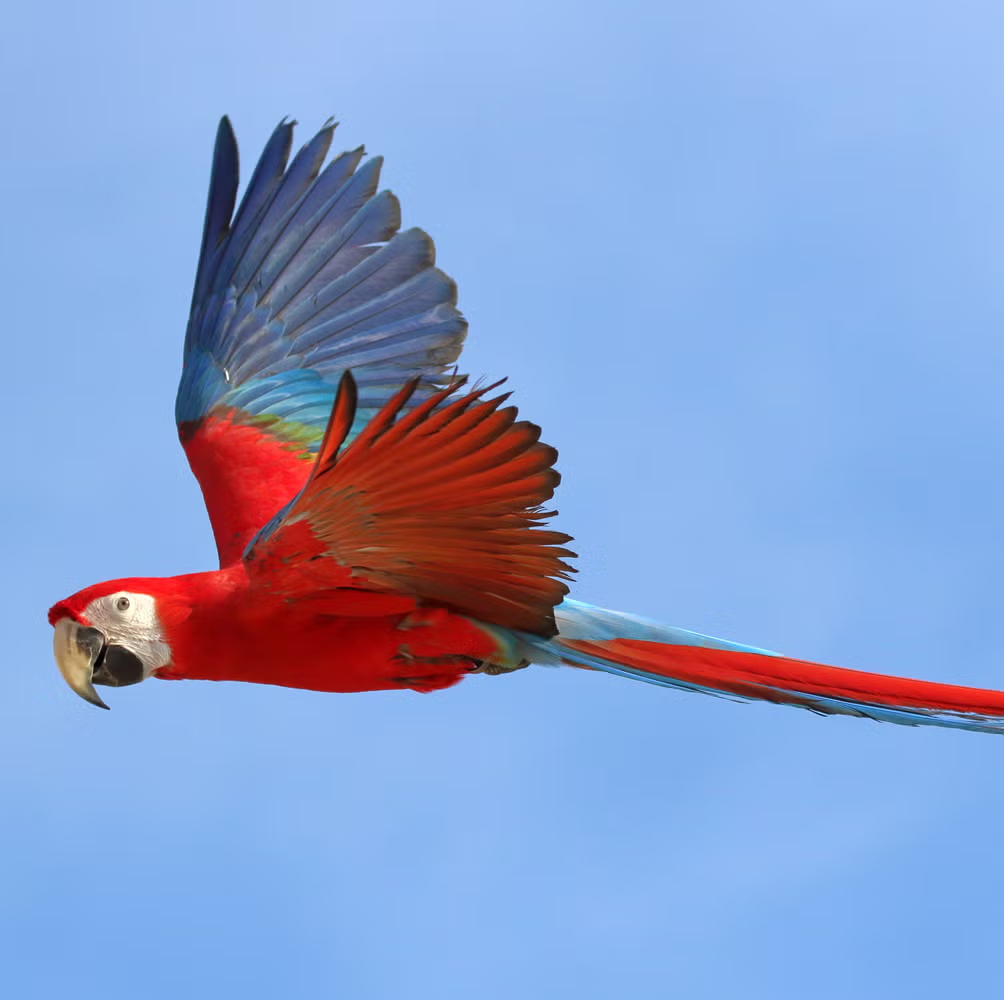
Description: The Scarlet Macaw (Ara macao) is a large, spectacular parrot native to humid evergreen forests in tropical Central and South America.17 It has brilliant red, yellow, and blue plumage, a powerful white and black beak, and makes loud, raucous calls. They often fly in pairs or small flocks and feed on fruits, nuts, and seeds.
42. Order Passeriformes – Perching Birds (Songbirds)
General Characteristics: This is by far the largest order of birds, containing over half of all living bird species – more than 6,000!.17 Commonly known as perching birds or songbirds, they are found worldwide and are incredibly diverse in size, color, diet, and behavior. Most have feet adapted for perching (three toes forward, one back) and complex vocal abilities, especially in the songbird group (Passeri suborder).21 This huge diversity highlights how successful this particular evolutionary design has been.
Example: American Robin
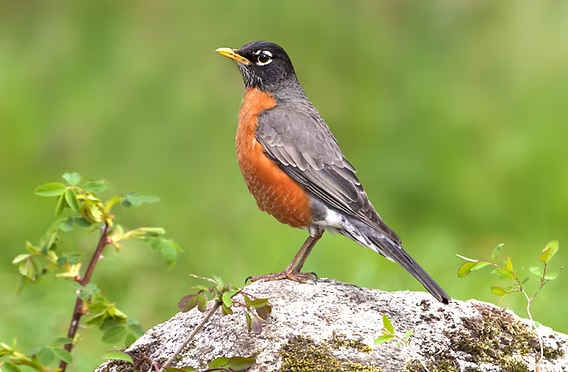
Description: The American Robin (Turdus migratorius) is a familiar songbird across North America, often seen hopping on lawns searching for earthworms.17 It has a gray back, warm orange breast, and a cheerful, caroling song. While common, it represents just one small twig on the massive Passeriformes family tree, which also includes sparrows, finches, warblers, crows, jays, swallows, and thousands more.
Why Does Grouping Birds Matter?
Learning about bird orders, families, and genera helps us appreciate the incredible variety of bird life on our planet.15 It’s not just about putting names on things; it’s about understanding relationships.
This classification system acts like a giant family tree, showing how different groups of birds evolved and are connected to one another through shared ancestors over millions of years.1
Knowing these groups helps scientists study bird behavior, ecology, and evolution more effectively.5 It also helps conservationists identify which groups might need special protection.
By understanding the unique features that define each order, we can better appreciate what makes each type of bird special.
So, the next time you see a bird, take a moment to observe it closely. Think about its beak shape, its feet, how it flies, or where it lives. You might start to see the clues that tell scientists which amazing order it belongs to!
Works cited
- Classification of Life | manoa.hawaii.edu/ExploringOurFluidEarth, accessed April 27, 2025, https://manoa.hawaii.edu/exploringourfluidearth/biological/what-alive/classification-life
- Classification of Living Things | CK-12 Foundation, accessed April 27, 2025, https://flexbooks.ck12.org/cbook/ck-12-middle-school-life-science-2.0/section/1.9/primary/lesson/organization-of-living-things-ms-ls/
- biological classification – Kids | Britannica Kids | Homework Help, accessed April 27, 2025, https://kids.britannica.com/kids/article/biological-classification/599565
- Scientific Classification – Biology for Kids – Ducksters, accessed April 27, 2025, https://www.ducksters.com/science/scientific_classification.php
- Taxonomy (biology) – Wikipedia, accessed April 27, 2025, https://en.wikipedia.org/wiki/Taxonomy_(biology)
- Seventh grade Lesson Biological Classification – Day 1 – BetterLesson, accessed April 27, 2025, https://teaching.betterlesson.com/lesson/638315/biological-classification-day-1?from=breadcrumb_lesson
- Classification – YouTube, accessed April 27, 2025, https://www.youtube.com/watch?v=DVouQRAKxYo&pp=0gcJCdgAo7VqN5tD
- Classification – YouTube, accessed April 27, 2025, https://www.youtube.com/watch?v=DVouQRAKxYo
- Taxonomy – Life Science for Kids! – YouTube, accessed April 27, 2025, https://m.youtube.com/watch?v=kfRBJqpavU0&pp=ygUKI2V0YXhvbG9neQ%3D%3D
- biological classification – Students | Britannica Kids | Homework Help, accessed April 27, 2025, https://kids.britannica.com/students/article/biological-classification/611149
- The Taxonomic Classification System | Biology for Majors I – Lumen Learning, accessed April 27, 2025, https://courses.lumenlearning.com/wm-biology1/chapter/reading-the-taxonomic-classification-system/
- a. Biological classification – BIOLOGY4ISC, accessed April 27, 2025, https://biology4isc.weebly.com/a-biological-classification.html
- Can someone explain the difference between species and genus? : r/Dinosaurs – Reddit, accessed April 27, 2025, https://www.reddit.com/r/Dinosaurs/comments/191k542/can_someone_explain_the_difference_between/
- Taxonomy for dummies – Nature Talk – iNaturalist Community Forum, accessed April 27, 2025, https://forum.inaturalist.org/t/taxonomy-for-dummies/37134
- Basis of Biological Classification – BYJU’S, accessed April 27, 2025, https://byjus.com/biology/biological-classification-basis/
- Orders of Birds – IOC World Bird List, accessed April 27, 2025, https://www.worldbirdnames.org/new/classification/orders-of-birds-draft/
- Orders – Bird Families of the World, accessed April 27, 2025, https://www.birdfamiliesoftheworld.com/orders/
- IOC World Bird List – Version 14.2, accessed April 27, 2025, https://www.worldbirdnames.org/new/
- Working Group Avian Checklists – International Ornithologists’ Union, accessed April 27, 2025, https://www.internationalornithology.org/working-group-avian-checklists
- Towards reconciliation of the four world bird lists: hotspots of disagreement in taxonomy of raptors – PMC, accessed April 27, 2025, https://pmc.ncbi.nlm.nih.gov/articles/PMC7329027/
- The Clements Checklist – GBIF, accessed April 27, 2025, https://www.gbif.org/dataset/47f16512-bf31-410f-b272-d151c996b2f6


